[PART ONE]
In 1931, a former collection of Chinese art objects of Dr. Manuel da Silva Mendes (°1876-†1931) was acquired by the Luis de Camões Museum. A long-time resident in Macao, Dr. Silva Mendes was a keen collector with a special interest in Chinese culture and Daoist philosophy. Besides pottery pieces from the Shiwan· kiln in Guangdong, · there are many Chinese paintings, mostly work of Guangdong artists, in the collection. The first part of this catalogue will discuss the Guangdong artists and their works; Part Two [See: SHEN, Chuang [Zhuang], Other Chinese Paintings in the Luís de Camões Museum, Macao] is devoted to other Chinese artists and paintings in the collection.
Interest in collecting art objects probably developed in Guangdong during the Ming· dynasty [1368-1644], and flourished in the Jiaqing· and Daoguang· eras of the late Qing· [1644-1912]. 1
According to literary sources, there were seventy-one Guangdong collectors during the Ming and Qing, 2 most of whom specialized in calligraphy and paintings. With the exception of six published catalogues from the late Qing period, 3 written records of the Guangdong collections are scarse. Moreover, the published collections for the most part included only a small number of Guangdong paintings. 4 Other Guangdong collectors as well as connoisseurs of art from other provinces, also preserved some Guangdong paintings. 5 In the late Qing period, for example, Pan Zhengheng· of Panyu· greatly appreciated the works of Li Jian. · It was said that Pan filled his studio with Li's calligraphy and paintings, and even named the studio after his favourite painter. 6 However, these collectors were only interested in the paintings of certain specific and well-known artists. They did not attempt a general collection. In his Wanmu caotang cangshumu· (Catalogue of the Wanmu caotang Collection), the collector Kang Youwei· (°1858-†1927) recorded thirty-eight paintings of Guangdong artists, 7 which were but a part of his collection of Chinese paintings. Unfortunately, Kang lacked a very deep understanding of the general development of Guangdong painting. In fact, he did not even realize that Mo Chi· was the style name of the famous Guangdong painter Zhang Ruzhi· (†1824) and considered him unknown. 8 Up to the time of the early Republic, there were still no Guangdong connoisseurs who systematically collected Guangdong paintings. There are several reasons for this, one being the insignificance of Guangdong painting when compared with the magnificent heritage of Chinese painting in general, 9 but it seems more likely that the lack of written records about Guangdong painting made it difficult for collectors to gain a perspective of the general development of the art form, and almost impossible to plan a systematic collection.
 Illustration 1
Two Storks 双鹳. .
LI XIANGGUANG 李翔光 (active eighteenth century).
tzu XING RU 星如.
Hanging scroll.
Slight colour on silk, 106.5×34.3 cm.
Inscribed and signed with 3 seals.
[Former] registration number: A78
In: [HC: KPLCM, M ], p.35, LI CHIEN ref. no 1 [plate 1].
Illustration 1
Two Storks 双鹳. .
LI XIANGGUANG 李翔光 (active eighteenth century).
tzu XING RU 星如.
Hanging scroll.
Slight colour on silk, 106.5×34.3 cm.
Inscribed and signed with 3 seals.
[Former] registration number: A78
In: [HC: KPLCM, M ], p.35, LI CHIEN ref. no 1 [plate 1].
During the early Republic [1912-1944], Guangdong collectors such as Liang Qichao· and Ye Gongchuo· began to preserve the paintings of their fellow countrymen. 10 In 1927, Wang Zhaoyong· of Panyu published his Lingnanhua zhenglue· (Observation on Lingnan Painting) — twelve juan· or chapters & in Shanghai,· the first book of the history of Guangdong painting ever written by a local author. In this book Wang listed four-hundred and fifty-eight painters from the Tang· [618-906] to the Qing dynasties. Since then the development of Guangdong painting has been more completely understood, and in 1961 the Lingnanhua zhenglue was reprinted in Hong Kong with a supplement. The latest edition lists six-hundred and seven painters from the Tang to the Qing."11
In 1934, the second National Art Exhibition was held in Nanjing., There were two-thousand entries, six-hundred of which were works of Guangdong artists. This exhibition was probably instrumental in arousing a deeper interest in Guangdong painting since it was at about this time that collections from Guangdong paintings gradually increased. Mr. Jian Youwen· began his comprehensive collection of Guangdong paintings (now in the Art Gallery of the Chinese University of Hong Kong) at that time, 12 but the Luís de Camões Museum collection had been established even earlier. The Luís de Camões Museum collection had already been completed by the time Jian Youwen began collecting. It has been preserved intact to the present.
In 1940, natives from Guangdong province who were living in Hong Kong organized an exhibition of Guangdong cultural materials in the Fung Ping Shan Library, · now the Fung Ping Shan Museum· of the University of Hong Kong. Nearly five hundred paintings representing the works of one-hundred and sixty-two Guangdong painters were on display, and a three-volume introduction, including studies of the general development of this provincial style, was published as a permanent record of the exhibition.
Many exhibitions of Guangdong paintings have been held in Hong Kong since, and the following illustrated exhibition catalogues have been published: 14
1. Guangdong mingjia shuhua xuanji· (Selected Paintings and Calligraphy by Renowned Painters of Kwangtung· [Guangdong]), Hong Kong, 1959 — An exhibition of calligraphy and paintings by famous Guangdong artists (comprised of artworks from several private collections in Hong Kong and Macao)
2. Guangdong mingjia huaji· (Collected Works by Renowned Guangdong Painters), Guangzhou, · 1961.
3. Su Lieupeng· Handbook, Hong Kong, The City Hall Museum and Art Gallery, 1964 & Catalogue of an exhibition of paintings by Su Liupeng.
4. Su Renshan· Handbook, Hong Kong, The City Hall Museum and Art Gallery, 1966 & Catalogue of an exhibition of paintings by Su Renshan.
5. Huatan guaijie Su Renshan· (Su Renshan eccentric genius of Guangdong: his life and art) Catalogue of an exhibition by Su Renshan's work, co-sponsored by the Centre of Asian Studies and the Fung Ping Shan Museum, from the collection of Mr. Jian Youwen. ·
6. RYCKMANS, Pierre, La vie et l'œuvre de Su Renshan, rebelle, peintre, et fou, 1814-1849 (?), Paris, Presses de l'Université de Paris, 1970 & This book is not an exhibition catalogue, but a study of the life and work of Su Renshan based on research sponsored by the Centre of Asian Studies of the University of Hong Kong. It was published in two volumes, the second of which contains onehundred and seventy-nine of the artist's paintings from public and private collections all over the world.
7. Landscape Paintings by Kwangtung [Guangdong] Masters during the Ming and Ch'ing· [Qing] Periods, Hong Kong, Institute of Chinese Studies of the Chinese University of Hong Kong, 1973 & Catalogue of an exhibition of landscape paintings by Guangdong masters during the Ming and Qing dynasties, organized by the Art Gallery of the Institute of Chinese Studies.
8. [Guangdong huace]· (Kwangtung Painting), Hong Kong, The City Museum and Art Gallery, 1973 & Exhibition catalogue.
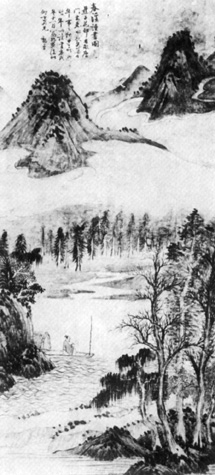 Illustration 2
Studying on a Boat in Springtime 春溪读书图.
LI JIAN 黎简(o1747-†1799).
tzu JIAN MIN 简民, hao ER QIAO 二樵.
Hanging scroll.
Colour on silk, 111.0 x 55.0 cm. Dated 1790.
Inscribed and signed with 1 seal. [Former] registration number: A52.
In: [HC: KPLCM, M ], p.34, LI CHIEN ref. no 2 [plate 3].
Illustration 2
Studying on a Boat in Springtime 春溪读书图.
LI JIAN 黎简(o1747-†1799).
tzu JIAN MIN 简民, hao ER QIAO 二樵.
Hanging scroll.
Colour on silk, 111.0 x 55.0 cm. Dated 1790.
Inscribed and signed with 1 seal. [Former] registration number: A52.
In: [HC: KPLCM, M ], p.34, LI CHIEN ref. no 2 [plate 3].
In all, two-hundred and seventeen Guangdong painters were introduced to the public through these exhibitions. Unfortunately, however, some of the exhibition catalogues do not illustrate every painting that was displayed, which makes it difficult to vizualise the style of many of the paintings. Relying solely on the catalogue illustrations, seven-hundred and fifty-two Guangdong paintings are known to us today, representing onehundred and fifty-four artists: thirty-three of these presently known painters are recorded in the Lingnanhua zhenglue. 15 It is evident that the number of artists whose works survive to this day is very small.
In the Luis de Camões Museum there are two-hundred and sixteen paintings, representing the work of forty-three Guangdong artists. Two of these painters are from the Ming dynasty, and the rest are all from the Qing. The preceding table lists the Guangdong painters in the Museum collection and classifies the paintings according to subject matter.
With the possible exception of unknown collections in mainland China, the former Jian Youwen collection, now in the Art Gallery of the Chinese University of Hong Kong, is the most important collection of Guangdong paintings. The Luis de Camões Museum collection, containing as it does works of more than a quarter of the published Guangdong painters, rank second in importance. The primary value of these works should not be ignored. Although Ming painters are minimally represented, more than half of the known Qing dynasty artists are included in the Luis de Camões Museum collection. Four of these, Chen Wang, · Li Xianggguang· [Illus.1], Guan Weixi, · and Su Fengsheng, · are painters whose works have never before been exhibited or published.
Two areas around the Pearl River delta were the centres of development of Guangdong painting. 16 Panyu, Shunde· and Nanhai· prefectures form one area, and Dongwan, · Xiangshan, · and Xinhui· provinces the other. Painters represented in the Museum collection are from both, particularly from Shunde and Nanhai.
 Illustration 3
Landscape in the Style of Li Tang 仿李唐意山水.
HE SHEN 何深(active early nineteenth century).
tzu HAI MEN 海门, hao XIAO QIAO SHAN REN 小樵山人.
Hanging scroll.
Slight colour on silk, 171.2 x 39.8 cm.
Inscribed and signed with 2 seals.
[Former] registration number: A3.
In: [HC: KPLCM, M ], p.32, HO SHEN ref. no 1 [plate 5].
Illustration 3
Landscape in the Style of Li Tang 仿李唐意山水.
HE SHEN 何深(active early nineteenth century).
tzu HAI MEN 海门, hao XIAO QIAO SHAN REN 小樵山人.
Hanging scroll.
Slight colour on silk, 171.2 x 39.8 cm.
Inscribed and signed with 2 seals.
[Former] registration number: A3.
In: [HC: KPLCM, M ], p.32, HO SHEN ref. no 1 [plate 5].
Landscape is traditionally considered to be the most important subject in Chinese painting, followed by bird-and-flower painting, while figure painting is held in least regard. As a European, however, Dr. Silva Mendes, the original owner of the collection, obviously preferred figure painting, which forms the bulk of his collection. The large number of figure paintings with a Daoist theme by Su Liupeng in the collection reflects Dr. Silva Mendes' interest in Daoism.
Seventy-six paintings in the Luis de Camões Museum collection are by Su Liupeng, and thirty-four by He Zhong. · Su was an outstanding figure painter of the Daoguang era, and He, a contemporary of Su, was a well-known bird-and-flower painter. As yet there has been no comprehensive study made of the styles of these two artists, but when such a study is made, the Luís de Camões Museum collection should prove invaluable.
LANDSCAPE PAINTING
The earliest landscape paintings in the Museum are the works by Li Jian17 (°1747-†1799)18 and most of the other landscapes in the collection are stylistically related to Li's. A painter and calligrapher, Li Jian was also hailed as one of the "Four Great Poets of Lignan".·19 Not tempted by the honour of official life, he was satisfied to be a professional painter. The Lingnanhua zhenglue attributes two styles to Li Jian, one which was bleak, desolate, and remote, in the manner of Ni Zan, · of the Yuan· dynasty, and the other, luxuriant, moist, and spontaneous, a revival of the classical style of Dong Yuan, · which Li reconstructed from his understanding of the paintings of Wu Zhen· of the Yan dynasty. In middle age, the master also deeply admired the style of Shi Tao, · according to Xie Lansheng,· a Guangdong painter of the following generation. 20
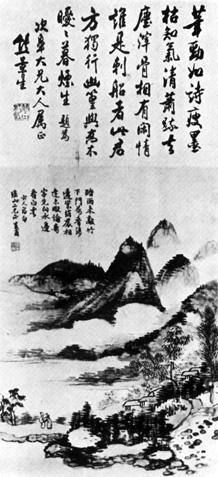 Illustration 4
Landscape 山水.
XIE LANSHENG 谢兰生(°1791-†1856).
tzu PEI SHI佩士, hao LI PU 澧浦
Hanging scroll. Colour on silk, 43.8 x 32.1 cm.
Inscribed and signed with 1 seal.
[Former] registration number: A186.
In: [HC: KPLCM, M ], p.33, HSIEH LAN-SHENG ref. no 1 [plate 6].
Illustration 4
Landscape 山水.
XIE LANSHENG 谢兰生(°1791-†1856).
tzu PEI SHI佩士, hao LI PU 澧浦
Hanging scroll. Colour on silk, 43.8 x 32.1 cm.
Inscribed and signed with 1 seal.
[Former] registration number: A186.
In: [HC: KPLCM, M ], p.33, HSIEH LAN-SHENG ref. no 1 [plate 6].
In the Luís de Camões Museum collection are seven Li Jian's landscape paintings, four of which are dated. 21 Of the seven paintings, 22 three are most significant to a study of the development of Li Jian's style: "Lingnan chunse"· ("Spring in Guangdong") [Plate 1], "Chuxi dushu tu"· ("Studying on a Boat in Springtime") [Illus.2], and "Youhe tingsong"· ("Listening to the Pines in a Secluded Ravine") [Plate 2].
"Spring in Guangdong" dated 1785 when Li Jian was thirty-five years old, is an example of the first, or bleak style. The date and location, inscribed in the painting, coincide with Li Jian's biographical data. 23 The inscription also points out that this is one of the "Bizhang hongmian"· ("Green Hills and Red Kapok") compositions, a favourite design that was originated by Li Jian. The kapok tree is a special Guangdong species that Li Jian described in his poetry24 as well as his painting. 25 Xie Lansheng once wrote that Li Jian was the first Guangdong landscape artist to paint the kapok tree. 26 In 1781 and 1782, he is said to have completed "Green Hills and Red Kapok" paintings, both of which are unfortunately lost. 27 "Spring in Guangdong" is thus a unique example of this type of composition.
The composition "Spring in Guangdong" is divided into two parts. In the foreground are a promontory, two kapok trees, and a large rock. Two figures are seen dodging between the rock and the trees. Across the river, the mid-ground terrace, closely knitted together with the mountain background, forms the second part. This two-divisional composition is similar to the design of Ni Zan and other late Yuan masters, although Ni Zan's landscapes seldom include figures. 28
 Illustration 5
Landscape 山水.
XIONG JINGXING 熊景星 (°1760-†1831).
tzu BO QING 伯晴, hao BO JIANG笛江
Hanging scroll.
Slight colour on paper, 137.8 x 37.0 cm.
Inscribed and signed with 2 seals.
[Former] registration number: A26.
In: [HC: KPLCM, M ], p.33, HSIUNG CHING-HSING
ref. no 1 [plate 8].
Illustration 5
Landscape 山水.
XIONG JINGXING 熊景星 (°1760-†1831).
tzu BO QING 伯晴, hao BO JIANG笛江
Hanging scroll.
Slight colour on paper, 137.8 x 37.0 cm.
Inscribed and signed with 2 seals.
[Former] registration number: A26.
In: [HC: KPLCM, M ], p.33, HSIUNG CHING-HSING
ref. no 1 [plate 8].
The placing of the figures between other larger elements is a design related to the Ming style of painting. 29 Another Ming feature is the unusual shape and perforation of the foreground rock which resembles the garden rocks that had gradually become popular in the Ming dynasty. It is similar to rocks in the paintings of the Ming literati. Indeed, even the mid-ground terrace is reminiscent of the style of Shen Zhou· of the Ming dynasty. 30 From this painting it is apparent that around 1785, Li Jian had combined the compositional style of Ni Zan with his interest in Ming painting to create "Green Hills and Red Kapok" design. Such Ming elements were apparently not noticed by the author of the Lingnanhua zhenglue.
A later landscape by Li Jian, "Zeng Caoting shanshuihua"· ("Landscape Painted for Caoting"), completed in 1795, 31 is even closer to the style of Ni Zan. In the foreground of the painting is a promontory with a boulder and a small pavilion with a few bamboos. The mid-ground is a strech of quiet waters, and a few rolling hills and distant trees constitute the background. The landscape, chilly and desolate, is rendered with very few textual strokes. In composition, in brush techniques, and in sentiment, the painting indicates to what an extent Li Jian, in his later years, had grasped the essence of Ni Zan.
"Studying in a Boat in Springtime", dated 1790, was executed in the style of Dong Yuan, •32 hao Beiyuan, • who was active in Jiangnan during the late Five Dynasties [907-960] period. Since the Ming dynasty, his landscapes had been considered an orthodox style. In the middle of the Qing dynasty, most of the works by Dong Yuan entered the Imperial collection. Thereafter, though he continued to be highly regarded by the general public, his style of painting was no longer widely seen or understood.
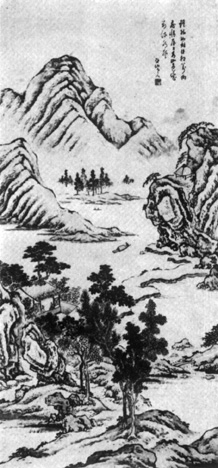 Illustration 6
Landscape 山水.
LI KUI 李魁(active mid-late nineteenth century).
tzu DOUSHAN 斗山
Hanging scroll.
Colour on paper, 118.8x33.7 cm.
Inscribed and signed with 2 seals.
[Former] registration number: A74.
In: [HC: KPLCM, M ], p.36, LI KU'EI ref. no 4 [plate 11].
Illustration 6
Landscape 山水.
LI KUI 李魁(active mid-late nineteenth century).
tzu DOUSHAN 斗山
Hanging scroll.
Colour on paper, 118.8x33.7 cm.
Inscribed and signed with 2 seals.
[Former] registration number: A74.
In: [HC: KPLCM, M ], p.36, LI KU'EI ref. no 4 [plate 11].
In this painting, Li Jian used hemp-fiber textual strokes to define the light and shade of the mountains and rocks, and large and small ink dots to indicate mosses and distant shrubs. The wooded mid-ground, the zig-zagging river bank, and the clouded mountains are no longer related to Ni Zan style, and the ink dots and hemp-fibre textual strokes are in fact distinctive techniques of Dong Yuan. 33 The zig-zagging stream in the centre of the painting is a distinguishing detail that often appears in the long handscrolls attributed to Dong Yuan. 34 In Dong Yuan's handscrolls, this stream would probably serve to emphasize the recession or depth of the scene, but in Li Jian's painting it seems to be a device to co-ordinate the mid-ground and the distant mountain. Although in the inscription Li Jian himself stated that the painting was executed in the manner of Beiyuan, with the exception of the above-mentioned characteristics, there are no other Dong Yuan features. The composition in particular, with a far-distant, screen-like high mountain, encircled by a piece of floating cloud, which entirely seals the background space, is close to the Northern Song [960-1127] formula, but it does not have the imposing atmosphere of its prototype, 35 nor is it similar to the ping yuan· (level distance) composition of Dong Yuan. 36
There are, however, three known paintings by Li Jian that are related to the style of Dong Yuan. The earliest, "Ni Beiyuan yunshan"• ("Free Copy of Dong Yuan's Clouded Mountain"), 37 is dated 1871. "Xiashan benyu tu"· ("Taking Shelter from the Rain in Summer Mountains, after Dong Yuan")38 is known to have been executed in 1790, the same year as "Studying on a Boat in Springtime". Unfortunately the owner of "Taking Shelter from the Rain in Summer Mountains, after Dong Yuan" cannot be traced, and "Studying on a Boat in Springtime" is the only example of the intermediate stage of Li Jian's study of Dong Yuan. In 1793 Li Jian complete "Xiashan yuyu tu"· ("Summer Mountains before Rain"), an example of his later study of the ancient master's style. After this period, he became absorbed in the study of Shi Tao and Dong Yuan's influence was no longer visible. 39
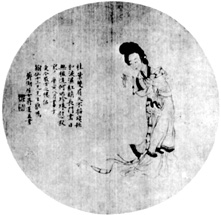 Illustration 7
Portrait of a Lady 白描仕女.
JIANG LIAN 蒋莲(active mid nineteenth century).
tzu XIANG HU 香湖.
Circular fan.
Ink on silk, 35.0 X 31.0 cm.
Dated 1830. Inscribed and signed with 2 seals.
[Former] registration number: AL1 no 2.
In: [HC: KPLCM, M ], P.28, CHIANG LIEN ref. no 1 [plate 12].
Illustration 7
Portrait of a Lady 白描仕女.
JIANG LIAN 蒋莲(active mid nineteenth century).
tzu XIANG HU 香湖.
Circular fan.
Ink on silk, 35.0 X 31.0 cm.
Dated 1830. Inscribed and signed with 2 seals.
[Former] registration number: AL1 no 2.
In: [HC: KPLCM, M ], P.28, CHIANG LIEN ref. no 1 [plate 12].
These landscapes, painted between Li Jian's thirty-fifth and his forty-seventh years, are milestones of his study of Dong Yuan's landscape style. The early "Free Copy of Dong Yuan's Clouded Mountain" is the least refined: the hemp-fibre textual strokes and ink dots are mechanical. The intermediate development manifested in "Studying on a Boat in Springtime" is more elegant. The high mountain background of this painting is comparable to that of the "Free Copy of Dong Yuan's Clouded Mountain", yet neither picture is a true reflection of the concepts of ping-yuan method of perspective. 41 A continuous movement into the picture's space is achieved by interposing layers of land with expanses of water. However the landscape is characterized by another feature: the many mountains terraces, which is definitely not a Dong Yuan's motif.
No genuine Dong Yuan paintings were preserved in Qing dynasty, and Li Jian, who had never travelled outside Guangdong and Guangxi· provinces, might not have seen any. Perhaps because he realized that genuine examples of the work of Dong Yuan and Ni Zan were difficult to find, he abandoned the classic style in his middle age and became interested in Shi Tao. He not only collected Shi Tao's paintings, but he also concentrated on imitating and interpreting the master's works. 42 "Listening to the Pines is a Secluded Ravine" in the Luis de Camões Museum collection is quite close to Shi Tao.
Shi Tao had expounded two theories of composition: fenjiang sandie· (lit: triple layered division of landscapes), which meant that the picture plane should be divided into three layers: land, trees and mountains; 43 and jieduan· (lit: segmentation), which was a method whereby the most beautiful part of the scene was intentionally isolated and emphasised by enlargement. 44 Li Jian's "Listening to the Pines in a Secluded Ravine" follows these principles. Two figures strolling across the foreground land, a line of pine trees in the mid-ground, and two hills in the far distance, with an expanse of water, boundless and undefined, on the right side of the picture; some parts of the scene are much larger and described in greater detail while the less important areas are screened by clouds in an exact manifestation of the jieduan method. The textual strokes employed by Li Jian to depict the mountains and rocks of this landscape are Shi Tao's common juanyun· (lit.: rolling clouds) strokes, 45 but since "Listening to the Pines in a Secluded Ravine" is painted on silk, it does not have the soft and diffused quality of Shi Tao's works which are usually executed on paper. 46 Although the painting is undated, it could not be earlier than Li Jian's middle age when he first became engrossed in the Shi Tao's style.
Li Jian himself analysed his style. In an album leaf dated 1794, he inscribed the folllowing:
"I have studied the art of painting for forty years. I reached a certain stage when I was thirty. Since then, I have often praised myself for some trifling achievements. In my forties, I re-examined the works executed in the thirties. The works I deemed exceedingly satisfactory then, I feel ashamed of today. In recent years I have truly accomplished something: my compositions are closer to nature, and my ink definition agrees with the reality of the corporeal world. As far as being visionary and transcendental, perchance I can produce these qualities but they cannot be controlled at will. In almost two months, between spring and summer, I have completed this album. It is primarily done in the manner of Dong Yuan and Wu Zhen. · There may be differences in ink shading, but the general concept can be viewed as a combination of the two masters [...] in the cyclical year of jiayin· (1794), the twenty-fourth day of the fourth month, er qiao,· Jian inscribed."47
The painters He Shen, · Lü Xiang, · Liang Shu, · Xie Lansheng, · Xiong Jingxing, · Ming Binglin, · Li Ruwei· and Luo Yang, · specimens of whose paintings are preserved in the Luis de Camões Museum, had all been in various respects under the widespread influence of Li Jian. He Shen was a student of Li Jian. His "Fang Li Tang biyi shanshui"· ("Landscape in the style of Li Tang") [Illus.3] is in fact very close to his teacher's "Summer Mountains before Rain" and not at all relevant to Li Tang's landscapes which are usually defined with 'axe-cutting' textual strokes. Lü Xiang and Liang Shu were Li's contemporaries and could have come under his influence when they gathered with him to discuss poetry and painting. 48 Xie Lansheng [Illus.4] was a generation younger than Li Jian. Xie Lansheng's painting improved notably after Li recommended the paintings of Shi Tao to him. 49 Ming Binglin is another painter who, in his later years, followed the style of Li Jian. 50 Li Ruwei's style [Plate 3] is more complicated, and influences ob both Li Jian and Xie Lansheng can be detected. The brushwork of Xiong Jingxing's ink monochrome landscape [Illus.5] is strong and dignified, comparable to the work of Gong Xian· of Chinling, and early Qing master. In general, the early Qing style had very little influence on Guangdong landscape painting, so that this example of Xiong Jingxing's is a rare and noteworthy specimen.
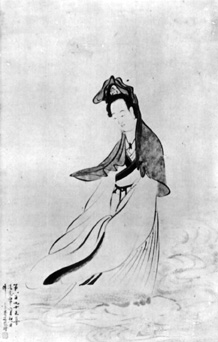 Illustration 8
Bodhisattva Avalokitesvara 观音图.
JIANG LIAN 蒋莲 (active mid nineteenth century).
tzu XIANG HU香湖.
Hanging scroll.
Colour on silk, 60.5 x 39.7 cm.
Dated 1836. Inscribed and signed with 1 seal.
[Former] registration number: A 101
In: [HC: KPLCM, M ], p.28, CHIANG LIEN ref. no 3 [plate 13].
Illustration 8
Bodhisattva Avalokitesvara 观音图.
JIANG LIAN 蒋莲 (active mid nineteenth century).
tzu XIANG HU香湖.
Hanging scroll.
Colour on silk, 60.5 x 39.7 cm.
Dated 1836. Inscribed and signed with 1 seal.
[Former] registration number: A 101
In: [HC: KPLCM, M ], p.28, CHIANG LIEN ref. no 3 [plate 13].
Unlike the celebrated Li Jian of the middle Qing, Li Kui· is a forgotten talent of the late Qing whose significance has long been neglected. In the 1940 exhibition of Guangdong cultural materials, the most comprehensive exhibition of its kind ever presented, although the works of one hundred and sixty two Guangdong artists were on display, Li Kuo was not included. 51 He was described as a "plaster artisan" and his paintings fetched very low prices. 52 It was not until 1959, when a book Guangdong mingjia shuhua xuanji was published, that one of his works was introduced. 53 In recent years his artistic achievement is gradually being recognized. 54
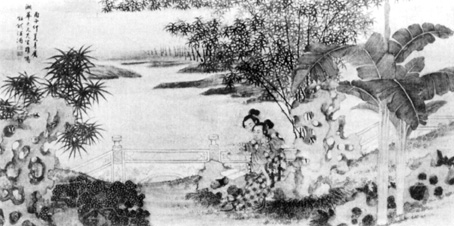 Illustration 9
Reading in the Garden 庭园人物之阅书图.
WANG PU 汪浦 (active late nineteenth century).
tzu YU BING 玉宾.
Album leaf.
Colour on silk, 28.2 x 53.8 cm.
Dated 1846. Inscribed and signed with 2 seals.
[Former] registration number: AL6 no 8.
In: [HC: KPLCM. M ], p.49, WANG P'U ref. no 2 [plate 15].
Illustration 9
Reading in the Garden 庭园人物之阅书图.
WANG PU 汪浦 (active late nineteenth century).
tzu YU BING 玉宾.
Album leaf.
Colour on silk, 28.2 x 53.8 cm.
Dated 1846. Inscribed and signed with 2 seals.
[Former] registration number: AL6 no 8.
In: [HC: KPLCM. M ], p.49, WANG P'U ref. no 2 [plate 15].
We know very little about Li Kui's life. Besides the succint record Lingnanhua zhenglue there is a more detailed biographical sketch of Li Kui in Li Fanfu's· article Qingmuo huaren Doushan· (A Late Qing Painter, Li Doushan). 55 According to these sources, Li Kui studied painting with the Guangdong artist Zheng Ji, · of Xinhui.· Later he became a professional painter, specializing in wall painting. He lived to a very old age. Judging by the dated paintings in the Luís de Camões Museum and other dated published works, Li Kui's active period was from approximately 1832 to 1871 or 1899. 56
The Luís de Camões Museum has for Li Kui landscapes, three of which are dated. The undated piece, titled simply "Shanshou jushou"· ("Landscape"), is signed "Doushan Laoren" · ("the old man of Dou Mountain"), and was probably painted when he was fifty-five. 57 The four Li Kui landscapes in chronological order are:
"Songyin caolu"· ("Thatched Hut under Shady Pines"), dated 1832 [Plate 4];
"Fang Wangshuming shanshui"· ("Landscape in the style of Wang Ming"), painted in the cyclical year of renyin, possibly 1842;
"Guang pu tu"· ("Watching the Waterfall"), painted in the cyclical year of bingwu, possibly 1846-1847. 58[Plate 5]
"Shanshou jushou" ("Landscape"), possibly a late work. [Illus.6]
An innovator, Li Kui followed no fixed rule. His composition and brush technique vary tremendously. He emphasized the atmospheric and transcendental qualities of the landscape. 59 Although he attempted to follow the style of the four late Yuan masters, Ni Zan, Wang Meng, · and Wu Zhen, · his "Landscape in the style of Wang Meng") gives very little indication of the style of the Yuan master. 60 His paintings rather reflect the influence of his teacher, Zheng Ji. "Thatched Hut under Shady Pines" is an example of Zheng Ji's influence. The landscape is composed of two pines and a thatched hut, inside which two men sit playing and listening to music. The pale and elegantly shaped mountain of he background contrast appropriately with the deep, dark foreground elements. In his Menghuanju huaxue jianming· (The Essence of the Painting Technique of the Menghuanju [Dream] Studio) (5 juan), Zheng Ji instructed:
"To paint a rustic scene of mountain and rocks should be presented to suggest an extensive atmosphere. The architectural elements should be thatch-roofed and bamboo-walled. They may be constructed by the river bank or beside tall pines. Only one or two mountain dwellers should be seen passing by, and there should be absolutely no trace of carriages and horses. There may be a solitary fisherman under a cliff or a willow tree, or there may be a few chanting birds perched on an unihabited pavilion near a bridge. This should provoke thoughts of another world in the minds of the beholders [...]."61
If this literary record is compared with the pictorial presentation "Thatched Hut under Shady Pines", it is not difficult to understand the relationship between the landscapes of Li Kui and Zheng Ji's theories of art.
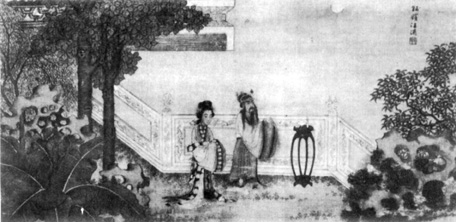 Illustration 10
Worshipping the Moon in the Garden
庭园人物之拜月图.
WANG PU 汪浦 (active late nineteenth century).
tzu YU BING 玉賓. Album leaf.
Colour on silk, 28.2 x 53.8 cm. Signed with 1 seal.
[Former] registration number: AL6 no 7.
In: [HC: KPLCM, M ], p.49, WANG P'U ref. no 5 [plate 16].
Illustration 10
Worshipping the Moon in the Garden
庭园人物之拜月图.
WANG PU 汪浦 (active late nineteenth century).
tzu YU BING 玉賓. Album leaf.
Colour on silk, 28.2 x 53.8 cm. Signed with 1 seal.
[Former] registration number: AL6 no 7.
In: [HC: KPLCM, M ], p.49, WANG P'U ref. no 5 [plate 16].
Another Li Kui's landscape, "Watching the Waterfall", is composed in such a way that the entire picture plane is defined without any blank space. This type of composition is certainly unique, but it corresponds exactly to another landscape of Zheng Ji62
About this type of virile and solid scene, Zheng Ji wrote:
"If it [i. e., the landscape] is intended to be powerful and solid, the brushwork should be rounded and strong. The textual strokes superimpose on one another. Repeat this brush technique again and again. Dry but dark ink should be used. Apply an ink wash afterwards for contrast. Subject elements need not to be abundant, but they must sustain a completeness of composition. Precipices and tall pines or a waterfall and a pavilion are elements which indicate height."63
About a method of rendering a tumbling waterfall and turbulent spring Zheng Ji wrote:
"In depicting a waterfall there should be two to four cascades. The rock formation of each cascade should vary. The course of water turns right and left; sometimes it is long and sometimes it is short. Sometimes it breaks and sometimes it continues. Still the upper cascade and the lower are always closely associated. Whenever stones are seen in the water, they must appear emergent. One half is exposed above water and the other half submerged. Therefore in the clear whirling water, paint a few large and small black stones."64
"Watching the Waterfall" is a work of Li Kui's middle age, but the influence of Zheng Ji's theory extended to his later years as is shown by the afore-mentioned large landscape in the Luís de Camões Museum with the signature "Doushan Laoren". The foreground of this landscape is dominated by three leafy trees, behind which spread, on the side, a small bridge spanning rippling water, and on the other side, thatched-roof houses with tall pines. A long river embankment connects with a mountain path and continues until it reaches a pavilion on a small mountain terrace. Distant slopes rise behind and fishing boats pass by.
About the composition of large landscapes, Zheng Ji commented:
"If it is meant to appear deep and expansive, the brushwork must be heavy and strong. Each stroke must be drawn with strenght generated from the wrist. As the saying goes, let it be dynamic and fresh. The ink should be dark and dry. The composition should be large, and separated into associated units. It should be well controlled like a heavenly horse which can fly freely and stop at will. 65
 Illustration 11
Awaiting the Rising Moon
桐阴伫月.
LUO ANXIAN 罗岸先, (active late nineteenth century).
tzu DENG DAO 登道, hao SAN FENG 三峰.
Hanging scroll. Colour on paper, 107.0 x 28.5 cm. Dated 1874.
Inscribed and signed with 2 seals.
[Former] registration number: A89.
In: [HC: KPLCM, M ], p.38, LO AN-HSIEN ref. no 8 [plate 17].
Illustration 11
Awaiting the Rising Moon
桐阴伫月.
LUO ANXIAN 罗岸先, (active late nineteenth century).
tzu DENG DAO 登道, hao SAN FENG 三峰.
Hanging scroll. Colour on paper, 107.0 x 28.5 cm. Dated 1874.
Inscribed and signed with 2 seals.
[Former] registration number: A89.
In: [HC: KPLCM, M ], p.38, LO AN-HSIEN ref. no 8 [plate 17].
If the road is not accessible, it must be obstructed, and therefore the painting is inarticulate. In such a case, there must be bridges to connect the land separated by the water. If the road is hidden by a rock, leave un undefined area to suggest the road. The road may encircle a house of thread through a forest and seem disconnected now and then. Figures in the picture may pass to and fro. This is what I mean by accessible."66
Li Kui practised not only his teacher's painting technique, but his philosophy of painting as well. Both men agreed on the necessity of capturing the atmospheric spirit and rhythm of the scene. Li Kui himself stated explicitly in the inscription for his "Fang Li Tang biyi shanshui"· ("Landscape after Li Tang"):
"People often spend too much time in pre-paring ink and brush. They stubbornly observe the six principles, which are treated as strictly as military rules. They do not realize that if too much stress is placed on these laws, the creative spirit will be imprisoned by them. In such cases, the artist will readily forget the thematic idea of the painting. When a painting lacks a central theme, it is far from being natural. How can a meaningless work have any transcendental quality?"67
Zheng Ji also said:
"Although painting is a minor skill, still it is necessary to study ink control and brush technique in order to grasp the form, idea, and spirit of the subject in mind. This is what I mean by acquiring the essence. Never rely solely on copying other paintings. Dare not be satisfied nor be self congratulatory about things half-finished."68
Lingnanhua zhenglue states that Li Kui followed the style of Shi Tao and created unusual landscape compositions. 69 But the remarkable paintings of Shi Tao had already been introduced to Guangdong artists by Li Jian and Xie Lansheng in the early nineteenth century, 70 and is not therefore surprising to find an element of Shi Tao in Li Kui's eccentric compositions. On the other hand, Zheng Ji's influence on his landscapes has long been neglected. It is this aspect that should rather be emphasized.
FIGURE PAINTING
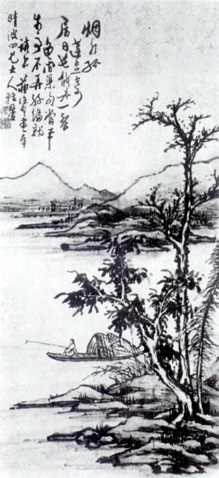 Illustration 12
A Hermit Fisherman 渔隐图.
SU FENSHENG 苏逢圣 (active late nineteenth century).
tzu QIN SUN 琴孙
Hanging scroll.
Slight colour on paper, 98.0 x 46.5 cm.
Inscribed and signed with 2 seals.
[Former] registration number: A 109.
In: [HC: KPLCM, M ], p.40, SU FENG-SHENG ref. no 1 [Plate 19].
Illustration 12
A Hermit Fisherman 渔隐图.
SU FENSHENG 苏逢圣 (active late nineteenth century).
tzu QIN SUN 琴孙
Hanging scroll.
Slight colour on paper, 98.0 x 46.5 cm.
Inscribed and signed with 2 seals.
[Former] registration number: A 109.
In: [HC: KPLCM, M ], p.40, SU FENG-SHENG ref. no 1 [Plate 19].
Guangdong figure painting includes portraiture, gübi shinü · paintings (portraits or genre scenes from the life of the upper classes in gongbi manner), baimiao· and xieyi· figure painting. 71 In the Luis de Camões Museum collection of Guangdong figure painting of the Qing dynasty, there are the following three types:
1. Shinü painting in the tradition of Tang Yin· and Qiu Ying· of the Ming dynasty, and Fei Danxu.· and Gai Qin· of the Qing dynasty;
2. the xieyi figure painting of Su Liupeng; and
3. figures with landscape settings in the manner of Hua Yan. ·
Chinese shinü painting has a long history. The silk painting from the Warring States period (481-221 BC), excavated at Changsha, is the oldest known specimen of the genre. 72 Since that time, shinü painting has continued to develop, with distinctive characteristics for each period. In the Ming dynasty, the modelling of the ladies in the shinü paintings of Tang Yin and Qiu Ying inclined to be refined and slender. The Qing dynasty artists continued to develop the style of their predecessors and created a handsome but extremely delicate image. This feminine image enjoyed great popularity then, and became a mainstream in the evolution of figure painting in the Qing dynasty.
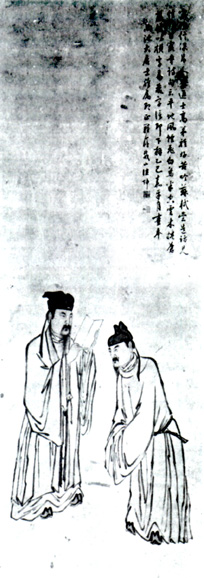 Illustration 13
Hsu Hsin and Su Shih 徐信与苏轼.
DE K-UN 德坤(active mid nineteenth century).
Surname LI 李 tzu QIN SUN 载山
Hanging scroll.
Colour on paper, 134.5 x 49.2 cm.
Inscribed and signed with 2 seals.
[Former] registration number: A170.
In: [HC: KPLCM, M ], p.47, TE K'UN ref. no 3 [plate 21].
Illustration 13
Hsu Hsin and Su Shih 徐信与苏轼.
DE K-UN 德坤(active mid nineteenth century).
Surname LI 李 tzu QIN SUN 载山
Hanging scroll.
Colour on paper, 134.5 x 49.2 cm.
Inscribed and signed with 2 seals.
[Former] registration number: A170.
In: [HC: KPLCM, M ], p.47, TE K'UN ref. no 3 [plate 21].
Jiang Lian, an accomplished Guangdong painter who was active in the middle of the nineteenth century, is represented in the Luís de Camões Museum by "Baimiao shinü"· ("Portrait of a Lady") in baimiao style painted on a round fan. [Illus.7]. This painting is important for an understanding of the development of Guangdong shinü painting. The picture, a careful portrayal of a beautiful lady with a dainty almond-shaped face, oblique eyes, long slender eyebrows, and a tiny red mouth, is wholly devoid of background. In composition and brush technique, the work is close to a certain type of shinü painting of Tang Yin, 73 while the modelling of the figure is similar to that of Fei Danxu of the Jiagnan district. 74 Jiang Lian not only used ink to delineate the figure, but also applied a light ink wash on the costume, a technique that can be traced to the ink wash baimiao of Li Tang· of the Southern Song dynasty (1127-1279). 75 Li Tang's famous "Cai hui tu"· ("Gathering Ferns") was already in the collection of the nineteenth century Guangdong collector Wu Rongguang· in 1825-1826, 76 when Jian Lian was asked by Wu to do some restoration work on another picture. 77 It is not unrealistic to assume that Jian Lian took the opportunity to study Li Tang's "Gathering Ferns" and was inspired by the master's technique.
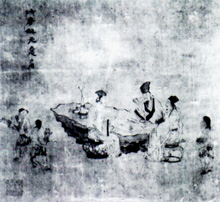 Illustration 14
Figures in the Style of Tang Yin 仿唐解元意人物.
SU LIUPENG 苏六朋(active mid nineteenth century).
tzu ZHEN QIN 枕琴, hao ZEN DAO REN 怎道人.
Album leaf.
Colour on silk, 39.0 x 30.0 cm.
Inscribed and signed with 1 seal.
[Former] registration number: AL2.
In: [HC: KPLCM, M ], p.45, SU LIU-P'ENG ref. no 55 [plate 23].
Illustration 14
Figures in the Style of Tang Yin 仿唐解元意人物.
SU LIUPENG 苏六朋(active mid nineteenth century).
tzu ZHEN QIN 枕琴, hao ZEN DAO REN 怎道人.
Album leaf.
Colour on silk, 39.0 x 30.0 cm.
Inscribed and signed with 1 seal.
[Former] registration number: AL2.
In: [HC: KPLCM, M ], p.45, SU LIU-P'ENG ref. no 55 [plate 23].
While "Portrait of a Lady' represents a distinctive type of Guangdong shinü painting of the late Qing period, it is also reprersentative of a particular stage of Jian Lian's artistic development." Portrait of a Lady" was painted in the cyclical year gengyin· (1830-1831). The style is as what Xie Lansheng remarked:
"Jiang began to portray figures. He studied all the different forms available. He was at the prime of his life then. Being dextrous, he could easily follow the style of Tang [Yin] and Qiu [Ying]."78
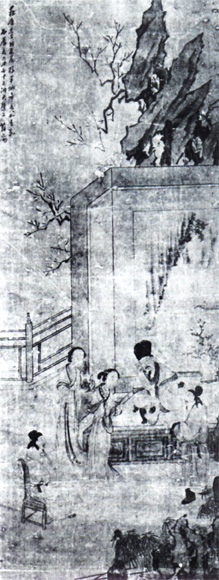 Illustration 15
Offering Wine 进酒图.
SU LIUPENG苏六朋 (active mid nineteenth century).
tzu ZHEN QIN 枕琴, hao ZEN DAO REN 怎道人.
Hanging scroll.
Colour on paper, 125.0 x 53.0 cm.
Dated 1856. Inscribed and signed with 2 seals.
[Former] registration number: A 151.
In: [HC: KPLCM, M ], p.43, SU LIU-P'ENG ref. no 27 [plate 24].
Illustration 15
Offering Wine 进酒图.
SU LIUPENG苏六朋 (active mid nineteenth century).
tzu ZHEN QIN 枕琴, hao ZEN DAO REN 怎道人.
Hanging scroll.
Colour on paper, 125.0 x 53.0 cm.
Dated 1856. Inscribed and signed with 2 seals.
[Former] registration number: A 151.
In: [HC: KPLCM, M ], p.43, SU LIU-P'ENG ref. no 27 [plate 24].
Two other Jiang Lian paintings in the Luis de Camões Museum, "Di yibai jiushi zun Guanyin"· ("Bodihisattva Avalokitesvara no. 190") [Illus.8] and "Shuxia renwu tu"· ("Figures Under a Tree") dated 1836 and 1837 respectively, are rendered with ease and much freedom. It was said that Jiang Lian built his Yü-t'ung Studio in Guangzhou in his old age and vowed to paint three hundred pictures of Buddha Sakyamuni and Bodhisattva Avalokitesvara as an attonement for his sins. 79 As is evident, the above are works of that period. 80
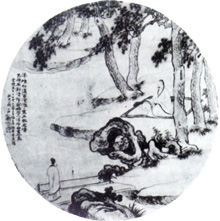 Illustration 16
Scholar in a Pine Forest in the Manner of Wen Cheng-
ming 法文待诏松林消夏图.
SU LIUPENG苏六朋 (active mid nineteenth century).
tzu ZHEN QIN 枕琴, hao ZEN DAO REN. 怎道人.
Circular fan.
Colour on silk, 36.0 x 32.0 cm.
Dated 1848. Inscribed and signed with 1 seal.
[Former] registration number: AL3.
In: [HC: KPLCM, M], p.42, SU LIU-P'ENG ref. no19 [plate 25].
Illustration 16
Scholar in a Pine Forest in the Manner of Wen Cheng-
ming 法文待诏松林消夏图.
SU LIUPENG苏六朋 (active mid nineteenth century).
tzu ZHEN QIN 枕琴, hao ZEN DAO REN. 怎道人.
Circular fan.
Colour on silk, 36.0 x 32.0 cm.
Dated 1848. Inscribed and signed with 1 seal.
[Former] registration number: AL3.
In: [HC: KPLCM, M], p.42, SU LIU-P'ENG ref. no19 [plate 25].
The dates of birth and death of Jiang Lian have not been established yet, but an inscription on Monk De Kun's· "Qinge tu"· ("Figures with a Qin") in the Luis de Camões Museum may help to shed light into this problem. Written in 1884 by Hu Daoren· who was seventy-five years old then, the inscription reveals that prior to Jian Lian's death, he suffered from some illness. When Jiang died in his early forties, the author was in his twenties. By deduction, when Jiang painted "Bodhisattva Avalokitesvara no. 190", the style of "Portrait of a Lady" is different and may be viewed as a work of Jiang's younger days.
The Jiangnan school of shinü was also popular in the late Qing Guangdong. The shinü paintings of Du Heng· [Plate 6] and of Wang Pu· [Illus. 9] [Illus. 10] share certain characteristics that are common to the Kiangnan school: careful brushwork; brilliant colours; and an elegant and decorative background setting. Du Heng and Wang Pu were immigrants from Jiangsu who, before moving to Guangdong, might have adopted some elements of Fei Danxu's style. At any rate their settlement in Guangdong promoted the transmission of the Jiangnan style, a style which continued to develop and was still in evidence in Guangdong in the late Qing period. Luo Anxian's· "Tongyin zhuyue"· ("Awaiting the Rising Moon") [Illus. 11 ] is a good example.
Du Heng's "Ba jun tu"· ("Eight Horses") [Plate 7] in the Luis de Camões Museum should be mentioned here. Although it does not have much bearing on the evolution of Guangdong painting, it is evidence of Du Heng's skill as an animal painter.
There are a great many xieyi figure paintings by Su Liupeng in the Luís de Camões Museum. Su Liupeng was an outstanding nineteenth century figure painter who had been tutored by the Monk De Kun of Baoji temple in Mount Luofu. · A prolific artist with broad interests, he depicted many historical stories and genre scenes, high dignataries as well as lowly characters. His paintings also reflect his special interest in Daoism, and indeed he wrote several books on Daoist subjects. 81
Su Liupeng's painting style is extremely complicated. Highly gifted, he was equally capable at painting large scrolls or miniatures of bold ar refined quality. Under his influence, his concubine Yu Ling· and his grandson Fengsheng· [Illus. 12] were both skillful painters. The paintings preserved in the Luis de Camões Museum reveal that between 1822 and 1858 his style varied a great deal. Sometimes these changes are obvious, but more often they are very subtle.
From 1822 to 1840 his painting style is associated with that of Shangguan Zhou· and De Kun. The Fujianese figure painter Shangguan Zhou had painted one-hundred and twenty portraits of Chinese officials. In the middle of the eighteenth century he took these portraits with him when he visited Guangdong. In 1743 he reproduced them in book form, the popular Wanxiaotang huapu· (Catalogue of Wangxiaotang [House of the Evening Laughter]). 82 The figures in this book are delineated in tiesimiao· (strokes resembling bending iron wire). Two Shangguan Zhou paintings in the collection of the Luis de Camões Museum, however, reveal other types of linear strokes he used: one has a heavy beginning and turning point and a thin but firm end, the form of which is like dingtou shuwei miao· (linear strokes in the shape of nail head and rat tail) [Plate 8]; the other is a similar shape but rendered much faster and more rhythmically, leaving white undefined areas in some strokes. A similar brush technique is seen in the paintings of De Kun [Illus. 13] and Su Liupeng [Plate 9], but each has his own individual style of drapery formation. The drapery folds of the De Kun's fugures are usually soft and closely arranged, while Su Liupeng's are firmer but spaced more widely.
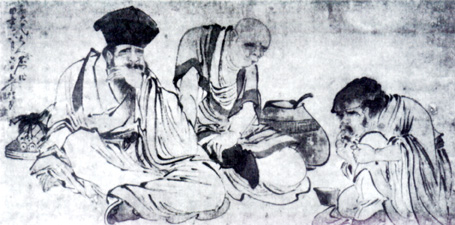 Illustration 17
Three Druken Men 三醉翁.
SU LIUPENG苏六朋 (active mid nineteenth century).
tzu ZHEN QIN 枕琴, hao ZEN DAO REN怎道人.
Hanging scroll (part of a tripthic).
Colour on paper, 80.8 x 160.5 cm.
Dated 1854. Inscribed and signed with 2 seals.
[Former] registration number: A 122.
In: [HC: KPLCM, M ], p.43, SU LIU-P'ENG ref. no 24 [plate 27].
Illustration 17
Three Druken Men 三醉翁.
SU LIUPENG苏六朋 (active mid nineteenth century).
tzu ZHEN QIN 枕琴, hao ZEN DAO REN怎道人.
Hanging scroll (part of a tripthic).
Colour on paper, 80.8 x 160.5 cm.
Dated 1854. Inscribed and signed with 2 seals.
[Former] registration number: A 122.
In: [HC: KPLCM, M ], p.43, SU LIU-P'ENG ref. no 24 [plate 27].
From 1840 to 1850, while Su Liupeng continued to explore the style of Shangguan Zhou and De Kun, practising finger painting as well, he also began to show interest in the figure painting of the Ming dynasty. Su Liupeng had obviously studied the art of Tang Yin. An album in the Museum dated 1845 contains a painting that is definitely stated to be in the manner of Tang Yin, "Fang Tang xie yuan yi"· ("Figures in the Style of Tang Yin"). [Illus. 14] A year earlier Su Liupeng had produced a huge composition "Tingqin tu"· ("Listening to the Qin"), 83 also reminiscent of the style of Tang Yin. The composition of the scroll "Jinjiu tu"· ("Offering Wine") [Illus. 15], dated 1856, resembles Tang Yin's "Fang tangren renwu tu"· ("Figures in Tang's Style") in the collection of the Palace Museum, Taibei.
During this period Su Liupeng was also imitating the style of Wen Zhengming· of the Ming dynasty. In the same album, there is a round fan, "Songlin xiaoxia tu"· ("Scholar in a Pine Forest in the Manner of Wen Zhengming") [Illus.16], dated 1848. Rendered with lanyemiao· (strokes in the shapes of an orchid leaf), the small figures in this fan painting are similar to figures in certain landscapes of Wen Zhengming. 84 Two years later, Su Liupeng applied a modified form of the same stroke to an exquisitely drawn portrait of the great poet, Tao Yuanming. · [Plate 10]
Evidently, before he studied the paintings of the Ming dynasty masters, Su Liupeng had acquired a comprehensive knowledge of paintings closer to his times.
After 1851 Su Liupeng continued to paint in all the different styles he had mastered previously [Illus.17], giving equal emphasis to each. These different facets of the style of Su Liupeng all reflect his superior associative and creative power. As far as his paintings in the Luís de Camões Museum collection are concerned, the influence of Shangguan Zhou e Du Kun's is most prominent.
The third type of Guangdong figure painting collected in the Luis de Camões Museum is closely associated with some paintings by Hua Yan· of the Yangzhou school of painting. Hua Yan (°1682-†1762 terminus a quo), painter and poet, had lived in Yangzhou, though he was a native of Fujian. In the Jiangnan area he was not considered a particularly outstanding member of the Yangzhou school, but in Guangdong his paintings won acclaim. 85 Hua Yan's figure painting, usually incorporated with some landscape elements such as a few trees and rocks, is elegant, pale, and uncluttered. The figures, in ink outline, are carefully drawn; drapery folds are only represented by a few lines. The facial features of these figures are lightly delineated with fine lines. 86 Of all these qualities, the most remarkable is Hua Yan's unique pobimiao· (broken brush strokes). 87 The linear brush strokes are executed in such a staccato manner that the resulting lines appear detached.
 Illustration 18 and Illustration 19
Figures in a Spring Scene in the Manner of Hua Yan
春景人物.
CUI QIN 崔芹 (°1845-†l914).
tzu YONG QIU 咏秋, hao HE SHAN SHAN QIAO 鹤山山樵.
Hanging scroll.
Colour on paper, 185.4 x 39.5 cm.
Inscribed and signed with 1 seal.
[Former] registration number: A200.
In: [HC: KPLCM, M ], p.48, TS'UI CH'IN ref. no 5 [plate 29].
Illustration 18 and Illustration 19
Figures in a Spring Scene in the Manner of Hua Yan
春景人物.
CUI QIN 崔芹 (°1845-†l914).
tzu YONG QIU 咏秋, hao HE SHAN SHAN QIAO 鹤山山樵.
Hanging scroll.
Colour on paper, 185.4 x 39.5 cm.
Inscribed and signed with 1 seal.
[Former] registration number: A200.
In: [HC: KPLCM, M ], p.48, TS'UI CH'IN ref. no 5 [plate 29].
He Zhong, • Cui Qin, • and Luo Anxian• of the late Qing all followed the figure painting style of Hua Yan. There is a figure and landscape composition, "Fang huaqiu yueshan shanshui yunyou"• ("Figures in Landscape in the Style of Hua Yan") (1879) [Plate 11] painted by He Zhong, in the Luis de Camões Museum, which with the exception of the more complicated drapery arrangement, is truly in the manner of Hua Yan, in both its composition and its technique. The foreground of the scrolls depicts only trees and rocks, the upright trees being the principal motif and the small rocks secondary. Two old men conversing animatedly in the mid-ground, and a corner mountain is faintly seen in the background. This composition is likely to be the prototype of "Ni Xie Tao guan chunjing renwu"• ("Figures in a Spring Scene in the Manner of Hua Yan") by Cui Qin [Illus.18] [Illus.19], ** who was in his turn a student of He Zheng and faithfully copied his teacher's compositional style. There are other paintings of Cui Qin in the Luís de Camões Museum which are similar to the above composition. Cui Qin strictly followed his teacher's technique for landscape, and in the portrayal of human figures his imitation of Hua Yan's pobimiao was even more remarkable.
Luo Anxian and He Zhong were contemporaries. Figure paintings by Luo Anxian in the Luis de Camões Museum collection include the above mentioned "Awaiting the Rising Moon", and a fan painting in the manner of Hua Yan, dated 1867. This fan composition is not comparable to the technique and composition of Hua Yan's figure painting, and shows above all that Luo Anxian did not understood the style of Hua Yan.
BIRD-AND-FLOWER PAINTING
As far as the surviving pictorial evidence is concerned, Guangdong bird-and-flower painting has a very long story. In the Luis de Camões Museum there are not many examples of this category, yet the collection covers works from Lin Liang· of the fifteenth century to Liu Luanxiang· of modem times.
Lin Liang was the creator of the ink monochrome bird-and-flower style in the Ming dynasty. His artistic achievement surpasses its provincial origin and he was oble to maintain an important position in the history of Chinese painting. His use of the ink and brush is free and vigorous, and the modelling of the birds is both realistic and natural. The composition achieves a certain beauty of design, full of variety.
In "Kongque tu"· ("Peacocks") [Plate 12], the body and long tail of the first peacock form a diagonal line that joins another arbitrary line defined by the inclined body of the second peacock and the silhouette of the cliff, forming a V-shape. From the cliff above hangs a branch of pines parallel to the position of the first peacock, and emphasizing the importance of the subject. All these diagonal line movements create a rhythmic composition which is graphically appealing.
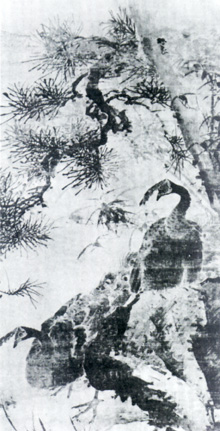 Illustration 20
Ducks on a Willowy Bank 芦岸水禽.
LIN LIANG 林良 (°1416-†l480).
tzu YI SHAN 以善.
Hanging scroll.
Ink on silk, 176.5 x 107.2 cm.
Signed with 1 seal. [Former] registration number: A63.
In: [HC: KPLCM, M ], p.37, LIN LIANG ref. no 3 [plate 32].
Illustration 20
Ducks on a Willowy Bank 芦岸水禽.
LIN LIANG 林良 (°1416-†l480).
tzu YI SHAN 以善.
Hanging scroll.
Ink on silk, 176.5 x 107.2 cm.
Signed with 1 seal. [Former] registration number: A63.
In: [HC: KPLCM, M ], p.37, LIN LIANG ref. no 3 [plate 32].
Lin Liang was a master of design. The focal points of two other compositions, "Lu'an shuiqin"· ("Ducks on a Willowy Bank") [Illus.20] and "Xueying tu"· ("Eagles in the Snow") are placed in the centre of the picture plane, forming 'centralized compositions'. "Ducks on a Willowy Bank" is divided longitudinally, on the right side there is a cluster of willow growing from right to left, while on the left another cluster grows from left to right. The two groups of willows form an axis that separates the two ducks on either side of the picture. This method of using a vertical element to separate the principal motifs on the right and left sides of the composition is repeated in the scroll "Eagles in the Snow": two eagles facing each other are separated by a withered tree between. Compositionally, this is more symmetrical than "Ducks on a Willowy Bank".
 Illustration 21
Eagle Seizing Prey 鹰攫图.
LIN LIANG 林良. (°1416-†1480).
tzu YI SHAN 以善.
Hanging scroll. Ink on silk, 151.0x75.4cm.
Signed with 1 seal. [Former] registration number: A65.
In: [HC: KPLCM, M ], p.37, LIN LIANG ref. no 2 [plate 33].
Illustration 21
Eagle Seizing Prey 鹰攫图.
LIN LIANG 林良. (°1416-†1480).
tzu YI SHAN 以善.
Hanging scroll. Ink on silk, 151.0x75.4cm.
Signed with 1 seal. [Former] registration number: A65.
In: [HC: KPLCM, M ], p.37, LIN LIANG ref. no 2 [plate 33].
 Illustration 22
Birds and Kapok 红棉松鸟.
HE ZHONG 何翀 (active late nineteenth century).
tzu DAN SHAN 丹山, hao YAN QIAO LAO 烟桥老人.
Hanging scroll.
Colour on paper, 174.1 x 48.1 cm.
Inscribed and signed with 1 seal.
[Former] registration number: A9.
In: [HC: KPLCM, M ], p.31, HO CHUNG ref. no 15 [plate 34].
Illustration 22
Birds and Kapok 红棉松鸟.
HE ZHONG 何翀 (active late nineteenth century).
tzu DAN SHAN 丹山, hao YAN QIAO LAO 烟桥老人.
Hanging scroll.
Colour on paper, 174.1 x 48.1 cm.
Inscribed and signed with 1 seal.
[Former] registration number: A9.
In: [HC: KPLCM, M ], p.31, HO CHUNG ref. no 15 [plate 34].
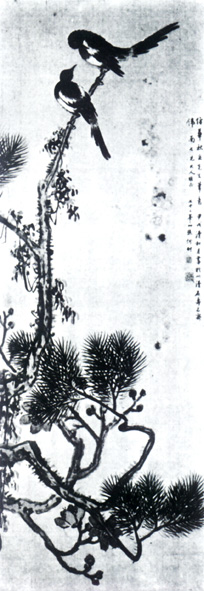 Illustration 23
Birds and Pines in the Style of Hua Yen 仿华秋岳松鸟.
HE ZHONG 何翀 (active late nineteenth century).
tzu DAN SHAN 丹山, hao YAN QIAO LAO REN 烟桥老人.
Hanging scroll.
Colour on silk, 130.5 x 47.2 cm. Dated 1874.
Inscribed and signed with 2 seals.
[Former] registration number: A27.
In: [HC: KPLCM, M ], p.31, HO CHUNG ref. no 10 [plate 35].
Illustration 23
Birds and Pines in the Style of Hua Yen 仿华秋岳松鸟.
HE ZHONG 何翀 (active late nineteenth century).
tzu DAN SHAN 丹山, hao YAN QIAO LAO REN 烟桥老人.
Hanging scroll.
Colour on silk, 130.5 x 47.2 cm. Dated 1874.
Inscribed and signed with 2 seals.
[Former] registration number: A27.
In: [HC: KPLCM, M ], p.31, HO CHUNG ref. no 10 [plate 35].
The above paintings represent birds in their quiet mood. "Yingjue tu"· ("Eagle Seizing a Prey") [Illus.21] is an example of Lin Liang's representation of birds in motion. This painting, full of drama, depicts the tragic moment as an eagle snatches a teal and soars high with the victim. The composition is divided into two sections. The upper left quadrant depicts and eagle seizing a teal. In the lower right a frightened teal and another bird huddle beneath lotus leaves and willow reeds. A diagonal can be vizualized connecting the willow reeds of the upper right comer with the lotus leaves and duckweeds of the lower left comer. This line divides the triumphant bird of prey in the upper section from the terrified pair of birds in the lower section. Again, another diagonal line can be formed by connecting an emmerging lotus pod by the side of the teal with the shooting eagle. This diagonal serves as a link between the upper left and the lower right quadrants. Witnesses to the tragedy, the teal and the other bird steadily watch the ennemy and his prey in horror. The connection between the upper and the lower section is emphasized by these strong associations. These invisible connecting and dividing lines contribute to greater pictorial interest, while the disorderly broken reeds and the rhythm of the swirling water denote an uneasy, struggling mood. Lu Liang not only studied the anatomy of the birds, but also, from the evidence of this painting, tried to dramatize their real-life situations, thus making another contribution to the category of bird-and-flower painting. 88
After Lin Liang, the most important bird-and-flower paintings in the Luis de Camões Museum collection are works by He Zhong of the Qing dynasty. He Zhong, active in the late nineteenth century, preserved the xieyi style which, in a larger sense, is a continuation of the tradition established by Lin Liang. He Zhong used three different basic compositions in his bird-and-flower paintings. The first is a combination of two principal vertical and horizontal lines which meet at a point on either the right or left side of the picture. These lines are usually represented in the form of a tree trunk and branches on which are perched a few birds. There is seldom any background. [Illus.22] [Illus.23] The second type of design, always divided into an upper and a lower section, is often executed on a long, narrow, hanging scroll format. The composition and motifs of the upper portion resemble the first type; but the lower part, usually depicting a river bank or the corner of a garden, is different. [Illus.24] [Illus.25] The third type is usually a representation of a limited garden scene with little attempt at depth [Illus.26]. He Zhong's style was quite influential: the bird-and-flower paintings of a later artist, Guan Weixi· [Illus.27], for example, are quite similar to He Zhong's second type of composition.
 Illustration 24
Peach Blossoms, Willows and Ducks 桃柳乳鸭.
HE ZHONG 何翀 (active late nineteenth century).
tzu DAN SHAN 丹山, hao YAN QIAO LAO REN 烟桥老人.
Hanging scroll.
Colour on silk, 147.0 x 35.5 cm. Signed with 2 seals.
[Former] registration number: A23.
In: [HC: KPLCM. M ], p.31, HO CHUNG ref. no 20 [plate 36].
Illustration 24
Peach Blossoms, Willows and Ducks 桃柳乳鸭.
HE ZHONG 何翀 (active late nineteenth century).
tzu DAN SHAN 丹山, hao YAN QIAO LAO REN 烟桥老人.
Hanging scroll.
Colour on silk, 147.0 x 35.5 cm. Signed with 2 seals.
[Former] registration number: A23.
In: [HC: KPLCM. M ], p.31, HO CHUNG ref. no 20 [plate 36].
 Illustration 25
Birds, Bamboo, Banana Leaves and Chrysanthemum
芭蕉竹鸟.
HE ZHONG 何翀 (active late nineteenth century).
tzu DAN SHAN 丹山, hao YAN QIAO LAO REN 烟桥老人
Hanging scroll.
Colour on silk, 147.0 x 35.3 cm.
Signed with 1 seal.
[Former] registration number: A 18.
In: [HC: KPLCM. M ], p.31, HO CHUNG ref. no 19 [plate 37].
Illustration 25
Birds, Bamboo, Banana Leaves and Chrysanthemum
芭蕉竹鸟.
HE ZHONG 何翀 (active late nineteenth century).
tzu DAN SHAN 丹山, hao YAN QIAO LAO REN 烟桥老人
Hanging scroll.
Colour on silk, 147.0 x 35.3 cm.
Signed with 1 seal.
[Former] registration number: A 18.
In: [HC: KPLCM. M ], p.31, HO CHUNG ref. no 19 [plate 37].
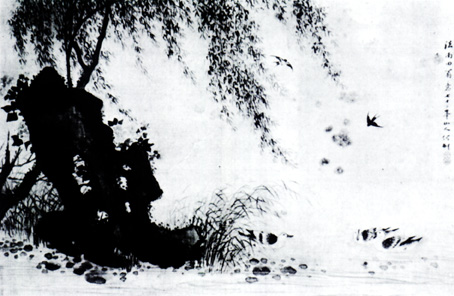 Illustration 26
Swallows and Ducks by a Willowy Bank 柳燕乳鸭.
HE ZHONG 何翀 (active late nineteenth century).
tzu DAN SHAN 丹山, hao YAN QIAO LAO REN 烟桥老人.
Album leaf.
Colour on silk, 32.0 x 47.8 cm.
Inscribed and signed with 1 seal.
[Former] registration number: AL6 no 10.
In: [HC: KPLCM. M ], p.32, HO CHUNG ref. no 33 [plate 38].
Illustration 26
Swallows and Ducks by a Willowy Bank 柳燕乳鸭.
HE ZHONG 何翀 (active late nineteenth century).
tzu DAN SHAN 丹山, hao YAN QIAO LAO REN 烟桥老人.
Album leaf.
Colour on silk, 32.0 x 47.8 cm.
Inscribed and signed with 1 seal.
[Former] registration number: AL6 no 10.
In: [HC: KPLCM. M ], p.32, HO CHUNG ref. no 33 [plate 38].
He Zhong was probably a late-nineteenth century contemporary of two other bird-and-flower painters & the Ju brothers, Ju Chao· and Ju Lian· & although the style of the Ju brothers is derived from the meigu· ('boneless'), technique of Song Guangbao· and Meng Jinyi · from Jiangnan, and is quite different from He Zhong.
There is a flower painting in the Luis de Camões Museum collection by Wu Deyi· [Illus.28], who was a student of Ju Lian. Judging from the evidence of this painting, however, the prototype could be traced back beyond Ju Lian at least to Lü Pei· of the early nineteenth century, and perhaps as far as Chen Chun· (°1483-†1544) of the Ming. The painting shows a host of narcissus placed in front of a contrastingly solid garden rock. Behind the rock, a few heavenly bamboo twigs suggest the dimmension of depth. This composition is almost exactly the same as "Sanyou tu"· ("The Three Friends") by Lü Pei, 89 but it is probably ultimately derived from Chen Chun. 90 Originating in the late fifteenth century, the design was popular in the Ming and early Qing and gradually became a standardized form. Wang Guxiang· (°1501-†1568), Chen Jiayan· (°late sixteenth century), and Wang Wu• (°1632-†1690) all painted similar designs. 91 By the late nineteenth century, this type of composition was still preserved only in Guangdong.
One of the important features of Guangdong painting is this preservation of classical styles when the contemporary trend in the rest of China is to abandon them. In landscape painting Guangdong artists perpetuayed the blue-and-green style in a period when ink monochrome landscapes were predominant in the rest of China. Another example of preserving and old style is the special technique in bird-and-flower painting called shuanggou, · that is, outlining the subjects depicted, as opposed to the more popular 'boneless' technique. In the Luis de Camões Museum collection this special shuanggou treatment of bamboo can be seen most notably in the "Zhuque tu"· ("Bamboo and Bird") painting by Liu Luanxiang [Illus.29] of the late nineteenth and early twentieth centuries. Earlier Guandong painters, such as Jian Lian, 92 Su Liupeng [Plate 13], and He Zhong, had also pictured bamboo in this fashion. This technique had been introduced in the Song dynasty. Both Zhang Xun· of the Yuan and Xia Chang· of the Ming had practised it, but by the Qing dynasty it had become almost a lost art. Only a few members of the Yangzhou school such as Jin Nong, ·93 Luo Pin, · and Hua Yan still favoured shuanggou. 94 These painters, or their pupils, were well-known in Guangdong and it was probably by their means that the classical technique was transmitted to Guangdong where it was maintained and perpetuated.
CONCLUSION
Although Lingnanhua zhenglue contains biographies of several hundred Guangdong painters, only a little more than a hundred sets of dates of birth and death of these artists are listed in the Supplement, and active periods of many important artists are still uncertain. The dated paintings in the Luis de Camões Museum collection should be a great aid to scholars, not only as primary evidence for the understanding of the development of individual artist, but also as guidelines for the establishment of their biographical data.
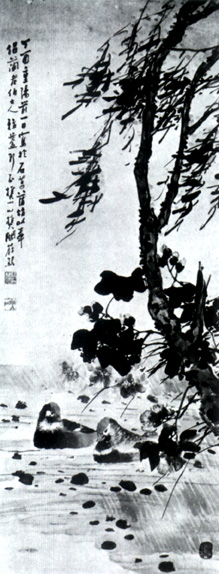 Illustration 27
Mandarin Ducks and Flowers Under a Willow Tree
柳下芙蓉鸳鸯.
GUAN WEIXI 关蔚熙(active late nineteenth century).
tzu XI CHEN 熙臣.
Hanging scroll.
Colour on paper, 132.0 x 60.5 cm.
Dated 1897. Inscribed and signed with 3 seals.
[Former] registration number: A46.
in: [HC: KPLCM. M ], p.33, KUAN WEI-HSI ref. no 1 [plate 39].
Illustration 27
Mandarin Ducks and Flowers Under a Willow Tree
柳下芙蓉鸳鸯.
GUAN WEIXI 关蔚熙(active late nineteenth century).
tzu XI CHEN 熙臣.
Hanging scroll.
Colour on paper, 132.0 x 60.5 cm.
Dated 1897. Inscribed and signed with 3 seals.
[Former] registration number: A46.
in: [HC: KPLCM. M ], p.33, KUAN WEI-HSI ref. no 1 [plate 39].
These dated pieces reveal that paintings in the Luis de Camões Museum collection are mostly early works of the Guangdong artists. In particular, the paintings by Li Jian, Jiang Lian, Su Liupeng, Li Kui, and He Zhong should be invaluable for any research into the lives and works of these artists.
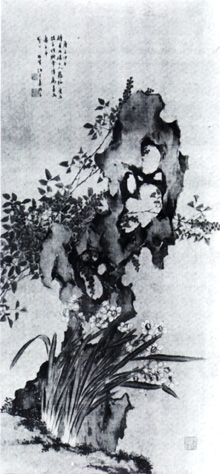 Plate 28
Narcissus, Heavenly Bamboo and Garden Rock 天竹水仙.
WU DEYI 伍德彝 ( 1921 terminus a quo).
tzu YI ZHUANG懿庄.
Hanging scroll.
Colour on silk, 84.0 x 41.0 cm.
Dated 1900. Inscribed and signed with 3 seals.
[Former] registration number: A222.
In: [HC: KPLCM. M ], p.50, WU TE-I ref. no 3 [plate 40].
Plate 28
Narcissus, Heavenly Bamboo and Garden Rock 天竹水仙.
WU DEYI 伍德彝 ( 1921 terminus a quo).
tzu YI ZHUANG懿庄.
Hanging scroll.
Colour on silk, 84.0 x 41.0 cm.
Dated 1900. Inscribed and signed with 3 seals.
[Former] registration number: A222.
In: [HC: KPLCM. M ], p.50, WU TE-I ref. no 3 [plate 40].
 Illustration 29 Birds and Bamboo 竹雀.
LIU LUANXIANG 刘鸾翔 (active mid nineteenth century).
tzu YU DI玉笙.
Hanging scroll.
Colour on paper, 134.0 x 33.0 cm.
Inscribed and signed with 1 seal.
[Former] registration number: A65.
In: [HC: KPLCM. M ], p.46, LIU LUAN-HSIANG ref. no 65 [plate 41].
Illustration 29 Birds and Bamboo 竹雀.
LIU LUANXIANG 刘鸾翔 (active mid nineteenth century).
tzu YU DI玉笙.
Hanging scroll.
Colour on paper, 134.0 x 33.0 cm.
Inscribed and signed with 1 seal.
[Former] registration number: A65.
In: [HC: KPLCM. M ], p.46, LIU LUAN-HSIANG ref. no 65 [plate 41].
Further research should also be carried out on the transmission and adaptation, during the Qing dynasty, of Jiagnan styles in Guangdong. The prefectures of Panyu, Shunde and Nanhai were art centres in Guangdong. The Luís de Camões Museum collection offers significant evidence that this tri-prefecture area in particular was a breeding ground for Jiangnan styles and it was from this centre that they spread throughout the rest of Guangdong province. Painters from Jiangnan either visited or settled in this region, like Du Heng and Wang Pu from Jiangsu, monk De Kun from Jiangxi, Shangguan Zhou from Fujian, and Song Guangbao and Meng Jinyi from Jiangnan, or influenced the Guangdong painters of the area more indirectly when their works were purchased by Guangdong collectors.
Guangdong painting in the Qing dynasty could be generally divided into two main streams of development: 95
1. Conservative yet gifted literati painters, whose works are characterized by accurate and careful brush strokes and a refined sense of colour and design, are closer to the traditional styles of other parts of China. Li Jian, Xie Lansheng and Liang Yuwei were representative landscape painters. The elegant figure paintings of Du Heng, Wang Pu and Jiang Lian, as well as the monochrome bird-and-flower studies of Zhang Jinfang, Lü Xiang and Huang Danshu, and paintings in the 'boneless' style of the Ju brothers must be included in this tradition.
2. At the same time, other painters were developing a more distinctively Guangdong style, full of vitality and local colour. The free and bold compositions of this group have a variety and eccentricity that is lacking in the more traditional school. This group is particularly well represented in the Luis de Camões Museum collection, with works by Su Liupeng, De Kun, Su Renshan, Li Kui, He Zhong, Cui Qin, and Luo Anxian. The collection will be an invaluable aid in any further research into this eclectic style. ***
Revised reprint from:
CHAN, Helen, PART I: & Kwangtung Paintings in the Luis de Camoes Museum, Macau, in CHAN, Helen, "A Catalogue of Chinese Paintings in the Luis de Camoes Museum: Macau", Macau, Imprensa Nacional, 1977 [The University of Hong Kong & Centre of Asian Studies Bibliographies and Research Guides, no. 11 (English)], pp.7-51.
CHINESE PAINTINGS IN THE LUÍS DE CAMÕES MUSEUM
PAINTER
height=1164>
PAINTER
|
style='font-size:7.5pt;mso-bidi-font-family:宋体'>BIRTHPLACE
lang=EN-US style='mso-bidi-font-family:宋体'>
|
COHRONOLOGY
|
lang=EN-US style='font-size:7.5pt;mso-bidi-font-family:宋体'>PAINTING
lang=EN-US style='mso-bidi-font-family:宋体'>
|
LAND-
SCAPES
|
FIGURE
|
BIRD &
FLOWER
|
ANIMAL
|
TOTAL
|
LIANG
style="mso-spacerun: yes"> 林 良
lang=EN-US style='mso-bidi-font-family:宋体'>
|
Nanhai 南 海
lang=EN-US style='mso-bidi-font-family:宋体'>
|
416-†1480????
lang=EN-US style='mso-bidi-font-family:宋体'>
|
style='mso-bidi-font-family:宋体'>
|
style='mso-bidi-font-family:宋体'>
|
5
|
style='mso-bidi-font-family:宋体'>
|
5
|
ZHANG MU 张 穆
lang=EN-US style='mso-bidi-font-family:宋体'>
|
Dongwan 东 莞
lang=EN-US style='mso-bidi-font-family:宋体'>
|
åmp;o1607-†1686 terminus a quo
lang=EN-US style='mso-bidi-font-family:宋体'>
|
style='mso-bidi-font-family:宋体'>
|
style='mso-bidi-font-family:宋体'>
|
1
|
style='mso-bidi-font-family:宋体'>
|
1
|
LI JIAN 黎 简
lang=EN-US style='mso-bidi-font-family:宋体'>
|
Shunde 顺 德
lang=EN-US style='mso-bidi-font-family:宋体'>
|
åmp;o1747-†1799
lang=EN-US style='mso-bidi-font-family:宋体'>
|
7
|
-
|
-
|
-
|
7
|
GUO SHI 郭 适
lang=EN-US style='mso-bidi-font-family:宋体'>
|
Shunde 顺 德
lang=EN-US style='mso-bidi-font-family:宋体'>
|
†1794
lang=EN-US style='mso-bidi-font-family:宋体'>
|
-
|
-
|
1
|
-
|
1
|
XIE LANSHENG 谢 兰 生
lang=EN-US style='mso-bidi-font-family:宋体'>
|
Nanhai 南 海
lang=EN-US style='mso-bidi-font-family:宋体'>
|
åmp;o1760-†1831
lang=EN-US style='mso-bidi-font-family:宋体'>
|
1
|
-
|
-
|
-
|
1
|
XIOANG JINGXING 熊 景 星
lang=EN-US style='mso-bidi-font-family:宋体'>
|
Nanhai 南 海
lang=EN-US style='mso-bidi-font-family:宋体'>
|
åmp;o1791-†1856
lang=EN-US style='mso-bidi-font-family:宋体'>
|
1
|
-
|
-
|
-
|
1
|
ZHAO ZIYONG 招 子 庸
lang=EN-US style='mso-bidi-font-family:宋体'>
|
Nanhai 南 海
lang=EN-US style='mso-bidi-font-family:宋体'>
|
åmp;o1793-†1846
lang=EN-US style='mso-bidi-font-family:宋体'>
|
-
|
-
|
1
|
2
|
3
|
HUANG BI 黄 壁
lang=EN-US style='mso-bidi-font-family:宋体'>
|
Chaoyang 潮 阳
style='mso-bidi-font-family:宋体'>
|
active XⅧth century
lang=EN-US style='mso-bidi-font-family:宋体'>
|
1
|
-
|
1
|
-
|
1
|
CHEN WANG 陈 汪
lang=EN-US style='mso-bidi-font-family:宋体'>
|
Nanhai 南 海
lang=EN-US style='mso-bidi-font-family:宋体'>
|
active XⅧth century
lang=EN-US style='mso-bidi-font-family:宋体'>
|
-
|
-
|
1
|
-
|
1
|
LI XIANGGUANG 李 翔 光
lang=EN-US style='mso-bidi-font-family:宋体'>
|
Xinhui 新 会
lang=EN-US style='mso-bidi-font-family:宋体'>
|
active XⅧth century
lang=EN-US style='mso-bidi-font-family:宋体'>
|
-
|
-
|
-
|
-
|
1
|
LI QI 黎 奇
lang=EN-US style='mso-bidi-font-family:宋体'>
|
Shunde 顺 德
lang=EN-US style='mso-bidi-font-family:宋体'>
|
active XⅧth century
lang=EN-US style='mso-bidi-font-family:宋体'>
|
-
|
-
|
-
|
1
|
1
|
LIANG SHU 梁 枢
lang=EN-US style='mso-bidi-font-family:宋体'>
|
Shunde 顺 德
lang=EN-US style='mso-bidi-font-family:宋体'>
|
active early XⅨth century
lang=EN-US style='mso-bidi-font-family:宋体'>
|
1
|
-
|
-
|
-
|
1
|
Lü XIANG 吕 翔
lang=EN-US style='mso-bidi-font-family:宋体'>
|
Shunde 顺 德
lang=EN-US style='mso-bidi-font-family:宋体'>
|
active early XⅨth century
lang=EN-US style='mso-bidi-font-family:宋体'>
|
1
|
-
|
2
|
-
|
3
|
Lü PEI 吕 培
lang=EN-US style='mso-bidi-font-family:宋体'>
|
Shunde 顺 德
lang=EN-US style='mso-bidi-font-family:宋体'>
|
active early XⅨth century
lang=EN-US style='mso-bidi-font-family:宋体'>
|
-
|
-
|
1
|
-
|
1
|
HE SHEN 何 深
lang=EN-US style='mso-bidi-font-family:宋体'>
|
Shunde 顺 德
lang=EN-US style='mso-bidi-font-family:宋体'>
|
active early XⅨth century
lang=EN-US style='mso-bidi-font-family:宋体'>
|
1
|
-
|
-
|
-
|
1
|
LI RUWEI 黎 如 纬
lang=EN-US style='mso-bidi-font-family:宋体'>
|
Shunde 顺 德
lang=EN-US style='mso-bidi-font-family:宋体'>
|
åmp;o1811
lang=EN-US style='mso-bidi-font-family:宋体'>
|
1
|
-
|
-
|
-
|
1
|
SU RENSHAN 苏 仁 山
lang=EN-US style='mso-bidi-font-family:宋体'>
|
Shunde 顺 德
lang=EN-US style='mso-bidi-font-family:宋体'>
|
åmp;o1814-†1849/1850
lang=EN-US style='mso-bidi-font-family:宋体'>
|
-
|
2
|
-
|
-
|
2
|
DU HENG 杜 衡
lang=EN-US style='mso-bidi-font-family:宋体'>
|
Panyu 番 禺
lang=EN-US style='mso-bidi-font-family:宋体'>
|
active mid XⅨth century
lang=EN-US style='mso-bidi-font-family:宋体'>
|
-
|
1
|
-
|
1
|
2
|
YU QILIN 余 启 璘
lang=EN-US style='mso-bidi-font-family:宋体'>
|
Shunde 顺 德
lang=EN-US style='mso-bidi-font-family:宋体'>
|
active mid XⅨth century
lang=EN-US style='mso-bidi-font-family:宋体'>
|
-
|
-
|
1
|
-
|
1
|
JIANG LIAN 蒋 莲
lang=EN-US style='mso-bidi-font-family:宋体'>
|
Xiangshan 香 山
style='mso-bidi-font-family:宋体'>
|
active mid XⅨth century
lang=EN-US style='mso-bidi-font-family:宋体'>
|
-
|
5
|
-
|
-
|
5
|
LUO YANG 罗 阳
lang=EN-US style='mso-bidi-font-family:宋体'>
|
Shunde 顺 德
lang=EN-US style='mso-bidi-font-family:宋体'>
|
active mid XⅨth century
lang=EN-US style='mso-bidi-font-family:宋体'>
|
3
|
-
|
-
|
-
|
3*
style='mso-bidi-font-family:宋体'>
|
DE KUN 德 坤
lang=EN-US style='mso-bidi-font-family:宋体'>
|
Guangdong 广 东
style='mso-bidi-font-family:宋体'>
|
active mid XⅨth century
lang=EN-US style='mso-bidi-font-family:宋体'>
|
1
|
7
|
-
|
-
|
8
|
SU LIUPENG 苏 六 朋
lang=EN-US style='mso-bidi-font-family:宋体'>
|
Shunde 顺 德
lang=EN-US style='mso-bidi-font-family:宋体'>
|
active mid XⅨth century
lang=EN-US style='mso-bidi-font-family:宋体'>
|
15
|
60
|
1
|
-
|
76
|
YU LING 余 菱
lang=EN-US style='mso-bidi-font-family:宋体'>
|
Guangdong 广 东
style='mso-bidi-font-family:宋体'>
|
active mid XⅨth century
lang=EN-US style='mso-bidi-font-family:宋体'>
|
-
|
2
|
-
|
-
|
2
|
JU CHAO 居 巢
lang=EN-US style='mso-bidi-font-family:宋体'>
|
Panyu 番 禺
lang=EN-US style='mso-bidi-font-family:宋体'>
|
†1889
lang=EN-US style='mso-bidi-font-family:宋体'>
|
-
|
1
|
-
|
-
|
1
|
JU LIAN 居 廉
lang=EN-US style='mso-bidi-font-family:宋体'>
|
Panyu 番 禺
lang=EN-US style='mso-bidi-font-family:宋体'>
|
åmp;o1828-†1904
lang=EN-US style='mso-bidi-font-family:宋体'>
|
-
|
-
|
6
|
-
|
6
|
MING BINGLIN 明 炳 麟
lang=EN-US style='mso-bidi-font-family:宋体'>
|
Nahai 南 海
lang=EN-US style='mso-bidi-font-family:宋体'>
|
active mid XⅨth century
lang=EN-US style='mso-bidi-font-family:宋体'>
|
1
|
-
|
-
|
-
|
1
|
DENG RUQIONG 邓 如 琼
lang=EN-US style='mso-bidi-font-family:宋体'>
|
Nahai 南 海
lang=EN-US style='mso-bidi-font-family:宋体'>
|
active mid XⅨth century
lang=EN-US style='mso-bidi-font-family:宋体'>
|
1
|
-
|
-
|
-
|
1
|
MENG ERZHU 蒙 尔 著
lang=EN-US style='mso-bidi-font-family:宋体'>
|
Panyu 番 禺
lang=EN-US style='mso-bidi-font-family:宋体'>
|
active mid XⅨth century
lang=EN-US style='mso-bidi-font-family:宋体'>
|
2
|
-
|
-
|
-
|
2
|
HE ZHONG
何翀
|
Nanhai 南 海
lang=EN-US style='mso-bidi-font-family:宋体'>
|
active mid XⅨth century
style='font-size:6.0pt;mso-bidi-font-size:12.0pt;mso-bidi-font-family:宋体'>
|
style='font-size:7.5pt;mso-bidi-font-family:宋体'>1
style='mso-bidi-font-family:宋体'>
|
style='font-size:7.5pt;mso-bidi-font-family:宋体'>5
style='font-size:6.0pt;mso-bidi-font-size:12.0pt;mso-bidi-font-family:宋体'>
|
style='font-size:7.5pt;mso-bidi-font-family:宋体'>27
style='mso-bidi-font-family:宋体'>
|
style='font-size:7.5pt;mso-bidi-font-family:宋体'>1
style='mso-bidi-font-family:宋体'>
|
style='font-size:7.5pt;mso-bidi-font-family:宋体'>34
style='mso-bidi-font-family:宋体'>
|
WU DEYI 伍 德 彝
lang=EN-US style='mso-bidi-font-family:宋体'>
|
Nanhai 南 海
lang=EN-US style='mso-bidi-font-family:宋体'>
|
†1921 terminus a quo
lang=EN-US style='mso-bidi-font-family:宋体'>
|
1
|
-
|
2
|
2
|
5
|
CUI QIN 崔 芹
lang=EN-US style='mso-bidi-font-family:宋体'>
|
Panyu 番 禺
lang=EN-US style='mso-bidi-font-family:宋体'>
|
åmp;o1845-†1914
lang=EN-US style='mso-bidi-font-family:宋体'>
|
-
|
6
|
-
|
-
|
6
|
WU XUEZAO 伍 学 藻
lang=EN-US style='mso-bidi-font-family:宋体'>
|
Shunde 顺 德
lang=EN-US style='mso-bidi-font-family:宋体'>
|
active late XⅨth century
lang=EN-US style='mso-bidi-font-family:宋体'>
|
1
|
1
|
-
|
-
|
2
|
WANG PU 汪 浦
lang=EN-US style='mso-bidi-font-family:宋体'>
|
Panyu 番 禺
lang=EN-US style='mso-bidi-font-family:宋体'>
|
active late XⅨth century
lang=EN-US style='mso-bidi-font-family:宋体'>
|
-
|
8
|
-
|
-
|
8
|
LUO ANXIAN 罗 岸 先
lang=EN-US style='mso-bidi-font-family:宋体'>
|
Panyu 番 禺
lang=EN-US style='mso-bidi-font-family:宋体'>
|
active late XⅨth century
lang=EN-US style='mso-bidi-font-family:宋体'>
|
-
|
2
|
6
|
-
|
8
|
LI KUI 李 魁
lang=EN-US style='mso-bidi-font-family:宋体'>
|
Xinhui 新 会
lang=EN-US style='mso-bidi-font-family:宋体'>
|
active mid-late XⅨth century
style='mso-bidi-font-family:宋体'>
|
4
|
-
|
-
|
-
|
4
|
GUAN WEIXI 关 蔚 煕
lang=EN-US style='mso-bidi-font-family:宋体'>
|
Nanhai 南 海
lang=EN-US style='mso-bidi-font-family:宋体'>
|
active late XⅨth century
lang=EN-US style='mso-bidi-font-family:宋体'>
|
-
|
-
|
1
|
-
|
1
|
JU QING 居 庆
lang=EN-US style='mso-bidi-font-family:宋体'>
|
Panyu 番 禺
lang=EN-US style='mso-bidi-font-family:宋体'>
|
active late XⅨth century
lang=EN-US style='mso-bidi-font-family:宋体'>
|
-
|
-
|
1
|
-
|
1
|
LUO QING 罗 清
lang=EN-US style='mso-bidi-font-family:宋体'>
|
Panyu 番 禺
lang=EN-US style='mso-bidi-font-family:宋体'>
|
active late XⅨth century
lang=EN-US style='mso-bidi-font-family:宋体'>
|
-
|
-
|
1
|
-
|
1
|
SU FENGSHENG 苏 逢 圣
lang=EN-US style='mso-bidi-font-family:宋体'>
|
Shunde 顺 德
lang=EN-US style='mso-bidi-font-family:宋体'>
|
active late XⅨth century
lang=EN-US style='mso-bidi-font-family:宋体'>
|
1
|
-
|
-
|
-
|
1
|
LIANG YUWEI 梁 于 渭
lang=EN-US style='mso-bidi-font-family:宋体'>
|
Panyu 番 禺
lang=EN-US style='mso-bidi-font-family:宋体'>
|
†1913
lang=EN-US style='mso-bidi-font-family:宋体'>
|
1
|
-
|
2
|
-
|
3
|
RONG ZUCHUN 容 祖 椿
lang=EN-US style='mso-bidi-font-family:宋体'>
|
Dongwan 东 莞
lang=EN-US style='mso-bidi-font-family:宋体'>
|
åmp;o1871-†1943
lang=EN-US style='mso-bidi-font-family:宋体'>
|
-
|
-
|
1
|
-
|
1
|
LIU LUANXIANG 刘 鸾 翔
lang=EN-US style='mso-bidi-font-family:宋体'>
|
Guangdong 广 东
lang=EN-US style='mso-bidi-font-family:宋体'>
|
active late XⅨth century
-early XⅨth century
lang=EN-US style='mso-bidi-font-family:宋体'>
|
-
|
-
|
1
|
-
|
1
|
TOTALS
lang=EN-US style='mso-bidi-font-family:宋体'>
|
lang=EN-US style='mso-bidi-font-family:宋体'>
|
lang=EN-US style='mso-bidi-font-family:宋体'>
|
46
|
100
|
63
|
72
|
16
|
NOTES
**Editor's note: The original edition shows a detail of Illustration 18. Not illustrated.
***Acknowledgements:
In compiling this catalogue, I am indebted to Mr. Zhuang Shen of the Department of Chinese, University of Hong Kong, for his constant guidance, and Professor Frank N. N. King for his invaluable editorial advice. Sincere thanks are also due to Miss Tsang Ka Bo· who contributed great assistance in various ways, and Mr. Shiu Koon Shing, ·Misses Victoria Mao, ·Angela Ng· for typing and copying the English and Chinese manuscripts. The Chinese paintings in Luis de Camoes Museum, Macau, were all photographed by Mr. Bobby Ching Do Ng" and his assistants, through the kind cooperation of the Curator, the late Mr. Luis G. Gomes, and this undertaking was financed by the Centre of Asian Studies, University of Hong Kong, with funds from the Harvard-Yenching Institute. Finally, I would like to extend my gratitude to the Macau Government and the Macau Municipal Council, which substantially supported the publication of this catalogue, to Mr. Gomes for his general encouragement, and to the other authorities in Macau. Dr. Margaret Ng saw the manuscript through the Press.
Helen Ho Chan
May 27, 1975
University of Hong Kong
1 XIAN, Yuqing 冼玉清, Guangdong zhi jianshangjia «广东之鉴赏家» (The Guangdong Connoisseur), in GUANGDONG wenwu zhanlanhui 广东文物展览会 Exhibition of Cultural Relics in Guangdong, ed., "Guangdong Wenwu" 广东文物 "Guangdong Cultural Relics", Xianggang 香港 Hong Kong, Zhongguo wenhua xin cihui 中国文化新词汇 New Glossary of Chinese Culture, 1941, part.3, juan 10, pp.982-997.
2 Idem. — The author recorded fifty-nine Guangdong collectors in her article.
Ver: WANG Zhaoyong 汪兆镛, Lingnanhua zhenglue «岭南画征略»(Observation on Lingnan Painting) + Liangnanhua zhenglue bukao «岭南画征略» (Supplement to Observation on Lingnan Painting), Xianggang 香港 Hong Kong, Commercial Press, 1961 [Revised edition] — Where the author listed twelve other collectors. All together there are seventy-one Ming and Qing collectors.
3 WU Rongguang 吴荣光, CH'I-yuan, ed., Xinchou xiaoxia ji «辛丑销夏记» (Summer of the Year Xinchou), 1905, juan 5; YE Menglong叶梦龙, RONG Geng 荣庚 manuscript copy, Fengmanlou shuhualu «风满楼书画录» (Catalogue of the Fengmanlou [Breezy Mansion] Collection of Calligraphy and Paintings), 1952, juan 4; PAN Zhengwei 潘正纬, in "Meishu" congshu 美术丛书 "Fine Arts" Series, ed., Tingfenglou shuhuaji «听风楼书画记» (Catalogue of the Tingfenglou [Mansion of the Breeze-Listening] Collection of Calligraphy and Paintings), 1947, vol.4, ser.7, juan 5; Tingfenglou shuhuaji bukao «听风楼书画记» (Supplement to the Catalogue of the Tingfenglou [Mansion of the Breeze-Listening] Collection of Calligraphy and Paintings), 1947, vol.4, ser.7, juan 2; KONG Guangtao 孔广陶, San-shih-yu-sanwan-chuan-t'ang, ed., Yuexuelou shuhualu «嶽雪楼书画录» (Catalogue of the Yuexuelou [Highlands Snow Mansion] Collection of Calligraphy and Paintings), 1889, juan 5; KANG Youwei 康有为 Wangmu caotang canghuamu «万木草堂藏画录», Shanghai上海, Changxing shudian 长兴书店 Changxing Books, 1918; LIANG Tingnan 梁廷楠, GU Delong shi zhongheyuan 顾德龙氏中和园 GU Delong Publishers, Tenghuating shuhuaba «藤花亭书画跋», [n. d.], juan 4 & Based on the "Mingchenglou" congshu "狻侧蚋丛书 " Mingchenglou" Series.
4 ZHUANG Shen 庄申, Lun shijiu shiji Guangdong shoucangjia suo cang zhi Guangdong huihua «论十九世纪广东收藏家所藏之广东绘画»(A Critical Appraisal of Nineteenth Century Guangdong Collectors), in "Mingbao yuekan" "狻报月刊 "Mingbao Monthly", (93) 1973, pp.34-35.
5 WANG Zhaoyon 汪兆镛, Lingnanhua zhenglue «岭南画征略» (Observing lingnan Painting), op. cit. & For paintings by Lin Liang 林良, Wang Houlai 汪后来, Zhang Mu张穆, Li Minhuai 黎民怀, Liu Jian 刘鉴, Huo Tao 霍韬, Hai Rui 海瑞, Li Suiqiu 黎遂球, Chang Jiayu 张家玉, Xue Shiheng 薛始亨, Chen Xuequan 陈学佺, Peng Ruiguan 彭睿瓘, Gao Yan 高俨 and He Chengheng 何澄亨, of the Ming dynasty; Wu Wei 吴韦, Gao Tianchong 甘天宠, Zhang Ruzhi 张如芝, Huang Peifang 黄培芳, Huang Danshu 黄丹书, He Shen 何深, Mu De Kun 德坤, Xie Lansheng 谢兰生, Mu Xiangrun 穆相润, Lü Pei 吕培, Zhao Ziyong 招子庸, Huang Lezhi 黄乐之, Liang Guoqi 梁国琦, Deng Tao 邓涛 and Wu Dan 吴旦, of the Qing dynasty.
6 Ibidem., juan 5, p.8.
7 KANG Youwei 康有为, op. cit., — Chapter on Paintings of the Qing dynasty.
8 Idem.
9 ZHUANG Shen 庄申, Guangdong lidai mingjia huihua «广东历代名家绘画» Some Observations on Kwangtung Paintings, in "Guangdong huace" "广东画册" Kwangtung Painting", [Exhibition Catalogue], Xianggang 香港 Hong Kong, City Museum & Art Gallery, 1973, p.9.
10 Caiyuan bingsou «菜园病叟» (Sick Old Man in the Herbal Garden), in "Xutan erjiao shanren huishi" "续谈二樵山人绘事"Supplement to the Biography of Erjiao Shanren", in "Silin" conglu "艺林丛录" "The Art" Series, Xianggang 香港 Hong Kong, Commercial Press, 1962, vol.3, p.64.
11 WANG Zhaoyong 汪兆镛, Lingnanhua zhenglue «岭南画征略» (Observing Lingnan Painting), op. cit.
12 JIAN Youwen 简又文, Guangdong shuhua jiancangji, «广东书画鉴藏记» (Appreciating and Collecting Guangdong Paintings &part. l), in "Guangdong wenxian jikan" "广东文献季刊" "Guangdong Documentation Quarterly", (4) 1972, juan 2, p.11.
GUANGDONG wenwu zhanlanhui, 广东文物展览会 Exhibition of Cultural Relics of Guangdong, ed., "Guangdong Wenwu" "广东文物"Guangdong Cultural Relics", Xianggang 香港 Hong Kong, Zhongguo wenhua xin cihui 中国文化新词汇 New Glossary of Chinese Culture, 1941.
14 HU Shih - KAO Weng - PRIEST, Alan, An Exhibition of Paintings by Kao Weng and Chang K'un-I, [Exhibition Catalogue], New York, The Metropolitan Museum of Art, 1944 & An exhibition of paintings by two exponents of the Lingnan school of painting.
15 Those who are not recorded in Lingnanhua zhenglue «岭南画征略» (Observation on Lingnan Painting) are mostly modern painters.
16 ZHUANG Shen 庄申, Guangdong lidai mingjia huihua «广东历代名家绘画» Some Observations on Guangdong Paintings, op. cit., pp. 10-12.
17 Li Jian 李简 is regarded as an exponent of the Qing dynasty Guangdong landscape painters. See: LI Zhujin李铸晋, Landscape Painting in Kwangtung During Ming and Ch'ing, in "Landscape Paintings by Kwangtung Masters During the Ming and Ch'ing Periods", [Exhibition Catalogue], Xianggang 香港 Hong Kong, Institute of Chinese Studies/Chinese University of Hong Kong, 1973.
18 SU Wenzhuo 苏文擢, Li Jian xiansheng wenpu «黎简先生年谱» (The Chronology of Mr. Li Jian), Xianggang 香港 Hong Kong, Chinese University of Hong Kong, 1973.
19 WANG Zhaoyong 汪兆镛, Lingnanhua zhenglue «岭南画征略»(Observation on Lingnan Painting), op. cit., juan 5, p.3 & For a biography of Li Jian.
20 XIE Lansheng 谢兰生, Changxingxingzhai shuhua tiba «常惺惺斋书画题跋»(Notes on the Changxingxingzhai Collection of Calligraphy and Paintings), last juan, p.51-b.
21 One of the dated paintings is dated the seventeenth year of the Jiaqing era (1812). Li Jian was no longer living then; therefore this painting is rather dubious.
22 One of the seven paintings in the style 'Huanghe shanqiao (Wang Meng)'黄鹤山樵 — 王蒙. Paintings of Li Jian in the manner of that master are very rare. Even Li Jianxianshen nianpu «黎简先生年谱» (The Chronology of Mr. Li Jian) records only one of such paintings. Since the inscription on the painting is a late addition, it may require further study in order to establish its authenticity.
Ver: SU Wenzhuo 苏文擢, op. cit., p. 124.
23 Ibidem, p.65.
24 Li Jian's poems on kapok trees written in 1782 and 1784 are two of the many examples of his literary descriptions of the tree.
See: LI Jian 李简, CH'EN-shih, rev. ed., Wubaisifengtang shichao «五百四峰堂诗钞»(Poems from Wubaisifengtang [Four Hills Study]), Guangdong 广东, Ju-ya-t'ang 聚雅堂 The House of Sophistication, 1874, juan 12, p.21-b, yuan 14, p.6-b.
25 In 1782 Li Jian painted "Green Hills and Red Kapok" (“珘嶂红棉图”) for Zhao Xihuang 赵希璜 as a farewell gift on his return to Huizhou. In a footnote to a poem inscribed on that painting, Li Jian wrote: "I was asked to paint by many people from other provinces. I often represent the "Green Hills and Red Kapok" to them. In the last five years tens of paintings of this particular motif have crossed the boundary of Guangdong."
Ver: LI Jian 李简 ,op. cit., juan 12, p.23.
26 XIE Lansheng 谢兰生, op. cit., juan 1, p.33-b.
27 Li Jian painted a "Green Hills and Red Kapok" (“珘嶂红棉图” ) for Lu Guanfu 陆贯夫, of Wuxian 吴县. The next year he painted another for Zhao Xihuang 赵希璜 of Changning 常宁.
See: SU Wenzhuo 苏文擢, op. cit., pp.42,46.
28 WEN Zhaotong 温肇桐, Yuanji sida huajia «元季四大画家» (Four Painters from Yuanji), Xianggang 香港 Hong Kong, 1960, p.22.
29 Wen Zhengming 文征明 of the Wu school of the Ming dynasty was interested in such a design.
See: SIREN, Osvald, Chinese Painting: Leading Masters and Principles, 4 vols., London - New York, 1956-1958, vol.4, plates [ills.] 205, 207, 209.
30 SHEN Zhou 沈周, "River View with a Qin Player" ("弹琴招月圆"), Abe Collection, Osaka Museum.
See: SIREN, Osvald, op. cit., vol.4, pp.158-159; vol.6, plate [ill.] 183.
31 SU Wenzhuo 苏文擢, op. crt., p. l31.
See: Landscape Paintings by Kwangtung Masters During the Ming and Ch'ing Periods, [Exhibition Catalogue], Hong Kong, Institute of Chinese Studies/ Chinese University of Hong Kong, 1973, plate [ill.] 48 & For an illustration of this painting.
32 Ibidem., p.101.
33 BARNHART, Richard, Marriage of the Lord of the River, in "Artibus Asiae Supplementum", Ascona, (XXVII) 1970, p.37.
34 Ibidem., p.20.
35 "Travellers on a Mountain Path" ("谿山行旅图"), by Fan Kuan 范宽, now preserved in the National Palace Museum, Taibei, Ver: SIREN, Osvald, op. cit., vol.3, plate [ill.] 154; Editorial Committee of the Joint Board of Directors, National Palace Museum and National Central Museum, ed., Three Hundred Masterpieces of Chinese Painting in the Palace Museum, Taichung, National Palace Museum - National Central Museum, 1959, vol.2, plate [ill.] 64.
36 BARNHART, Richard, op. cit., pp.22-37.
37 Landscape Paintings by Kwangtung Masters During the Ming and Ch'ing Periods, op. cit., plate [ill.] 41
38 This handscroll has been in the collection of Ye Menglong.
See: YE Menglong 叶梦龙, RONG Geng 荣庚,[manuscript copy], op. cit., juan 3, p.56; SU Wenzhuo 苏文擢, op. cit., p.96.
39 ZHUANG Shen 庄申, Yueji shoucangjia yu qingchu geren zhuyi huapai zhi guanxi «粤籍收藏家之藏品与清初个人主义画派之关系» Rapport Between Guangdong Collectors and the Individualistic Painting Genre of the Early Qing), [manuscript].
Li Jian could have modelled his composition after certain dubious Dong Yuan 董源 paintings, and "Free copy of Dong Yuan's Clouded Mountain" is, incidentally, a copy of such a landscape.
See: Zhina nanhua dacheng «支那南画大成» (South China Paintings), Tokyo, Kobunsha, 1936-1937, juan 9, plate [ill.] 8.
41 Guangdong mingjia huaji «广东名家画集» (Collected Works by Renowned Guangdong Painters), Guangdong 广东, Zhongguo meishujia xiehui Guangdong fenhui 中国美术家协会广东分会The China Association of Fine Artists from Guangdong, 1961. plate [ill.] 39.
42 LI Zhujin 李铸晋,op. cit.
43 SHI Tao 石涛, ZHU Jihai 朱季海, annot, Shi Too huapu «石涛画谱», Zhonghua shuju Xianggang fenju 中华书局香港分局 China Books - Hong Kong Branch, 1973, p.49.
44 ZHENG Zhuolu 郑拙卢, Shi Tao yanjiu «石涛研究» (A Study on Shi Tao), Beijing 北京, Renmin meishu chubanshe 人民美术出版社 The People's Fine Arts Publishers, 1961, pp.56, 63.
45 In 1781, a poem written by Li Jian, Zhang Jinfang «张锦芳»(Zhang Jifang) noticed that Li's brushwork was close to that of Shi Tao.
See: SU Wenzhuo 苏文擢, op. cit., p.41.
46 ZHENG Zhuolu 郑拙卢, op. cit., p.65.
47 Li Jian, landscape album with twelve leaves, on paper. See: PAN Zhengwei 潘正纬, in "Meishu" congshu "美术丛书" "Fine Arts" Series, ed., Tingfenglou shuhuaji bukao (Catalogue of the Tingfenglou [Mansion of the Breeze-Listening] Collection of Calligraphy and Paintings), op. cit., juan 2, p.665.
48 WANG Zhaoyong 汪兆镛, Lingnanhua zhenglue «岭南画征略» (Observing Lingnan Painting), op. cit., juan 6, p.18 & Biography of Lü Xiang 吕翔.
49 ZHUANG Shen 庄申, Yueji shoucangjia [...], op. cit.
50 WANG Zhaoyong 汪兆镛, Liangnanhua zhenglue «岭南画征略»(Observing Lingnan Painting), op. cit., p.17 & Biography of Ming Binglin 明炳麟.
51 GUANGDONG wenwu zhanlanhui 广东文物展览会Exhibition of Cultural Relics from Guangdong, ed., op. cit., juan 1, part.3, pp.12-19.
52 LI Fanfu 李凡夫, Qingmo huaren Li Doushan «清末诗人李斗山» (Li Doushan, the Late-Qing poet), in "Yilin" conglu "艺林丛录" " The Art" Series, Xianggang 香港 Hong Kong, Commercial Press, 1961, vol.3, pp.83-84.
53 Guangdong mingjia shuhua xuanji «广东名家书画选集»(Selected Paintings and Calligraphy by Renowned Painters of Kwangtung), Xianggang香港Hong Kong, 1959, p.48 1 Li Kui 李魁, "Landscape" ("卷轴"), hanging scroll.
54 Li Kui has been singled out as one of the representatives of landscape painters of his time.
See: LI Zhujin 李铸晋, op. cit.
55 LI Fanfu 李凡夫, op. cit.
56 There is one statement that he died at the age of seventy, but another indicates that he was still painting at eighty-eight.
"Thatched Hut Under Shady Pines" ("松阴草卢"), in the Luís de Camões Museum collection is dated 1832. Besides this two other landscapes by Li Kui are dated 1871 and 1899 respectively. From 1832 to 1899 there is a period of sixty-seven years. If Li Kui did in fact live to an age of eighty-eight, the time between 1832 to 1899 would be considered his active period.
See: LI Fanfu 李凡夫, op. cit., p.84; WANG Zhaoyong 汪兆镛, Lingnanhua zhenglue «岭南画征略»(Observing Lingnan Painting), op. cit., juan 10 & For a biography of Li Kui.
57 Works by Li Kui executed after he was fifty-five are usually signed "Doushan Laoren" 斗山老人.
See: LI Fanfu 李凡夫, op. cit.
58 The cyclical year of this painting, bingwu 丙午, has been equated to 1906. However, new material on Li Kui shows that it is probably necessary to revise this. First, in 1906 Li Kui must have been an old man. According to the above, his late works are usually signed "Doushan Laoren" 斗山老人, but "Watching the Waterfall ("观瀑图") is signed by Li Kui and bears the seal mark of "Doushan Shanren" " 斗山山人, and "Hangzhou Huaren" 冈州画人. Secondly, supposing if "Thatched Hut Under Shady Pines" ("松阴草卢 "), dated 1832, in the Luis de Camões Museum collection is the earliest work of Li Kui and "Watching the Waterfall" his latest work and if 1906is the date of the latter, the time between the two paintings is seventy-four years; and if Li Kui lived to an age of eighty-eight, then "Thatched Hut Under Shady Pines" would be the work of a fourteen year old. It needs further research to prove that a fourteen year old could produce such excellent work. Thirdly, there is a miniature landscape by Li Kui (painted on one half of a circular fan) for a patron named Tan Yuan reproduced in Landscape Paintings by Kwangtung Masters During the Ming and Ch'ing Periods. Stylistically, the textual of this landscape resemble the large rock emerging from the rapids in "Watching the Waterfall". Though undated, the other half of the fan is inscribed for the same patron by Xiong Jingxing 熊景星, who died in 1856. Therefore, the landscape by Li Kui painted on the same fan must have been completed prior to this date. Since the style of "Watching the Waterfall" is so close to this landscape, it was probably painted about the same period. Accordingly, before any new discovery is made, the date of "Watching the Waterfall" should not be later than 1856 and the cyclical year bingwu could very likely be the twenty-sixth year of the Daoguang 道光era (1846).
See: [Guangdong huace] «广东画册» Kwangtung Painting, [Exhibition Catalogue], op. cit., plate [ill.] 80, p. 134; Landscape Paintings by Kwangtung Masters During the Ming and Ch'ing Periods, op. cit., plate [ill.] 119.
59 Ibidem., plate [ill.] 117 & For an inscription by Li Kui on his "Landscape after Ni Zan" ("仿倪瓒山水")
60 Ibidem., plates [ills.]117-125.
61 ZHENG Ji郑绩, Hualu congkan «画论丛刊岓» (The Theory of Graphic Art), in YU Anlan 余安兰 (Yu Anlan) ed., "Menghuanju huaxue jianming" «梦幻居画学简明» ("The Essence of the Painting Technique of the Menghuanju [Dream] Studio"), Beijing, Renmin meishu chubanshe 人民美术出版社 The People's Fine Arts Publishers, 1962, vol.2, juan 1, Lunjing pian «论忌篇»(An Essay on Atmosphere).
62 Landscape Paintings by Kwangtung Masters During the Ming and Ch'ing Periods, op. cit., plate Jill.] 109.
63 ZHENG Ji 郑绩, op. cit., juan 1, Lunyi pian «论意篇» (An Essay on Mood).
64 Ibidem., juan 1, Lunquan pian «论泉篇» (An Essay on Painting Springs and Rivers).
65 Ibidem., juan 1, Lunyi pian «论意篇» (An Essay on Mood).
66 Ibidem., juan 1, Lunji pian «论忌篇» (An Essay on Taboo Subjects in Painting).
67 See: note 59.
68 ZHENG Ji 郑绩, op. cit., juan 1, Shanshui zonglun pian «山水总论篇» ( An Essay on Landscape Painting).
69 WANG Zhaoyong 汪兆镛, Lingnanhua zhenglue «南画征略» (Observing Linghua Painting), op. cit., juan 10 & For the biography of Li Kui.
70 ZHUANG Shen 庄申, Yueji shoucangiia [...], op. cit.
71 TAM, Laurence C. S. 谭志成, An Introduction to the Development of Kwangtung Painting. in "Guangdong huace" "广东画册" "Kwangtung Painting", [Exhibition Catalogue], Hong Kong, City Museum &; Art Gallery, 1973, pp.40-43.
72 This painting is now in the Beijing Historical Museum collection. See: SIREN, Osvald, op. cit., vol.3, plate [ill.] 1.
73 Ibidem, vol.6, plate [ill.] 231 & Tang Yin 唐寅 "The Fairy Chang'e with a Branch of Cassia" (“狾桂嫦娥图).
See: Editorial Committee of the Joint Board of Directors, National Palace Museum and National Central Museum, ed., Three Hundred Masterpieces of Chinese Painting in the Palace Museum, op. cit., vol.5, plate [ill.] 233 & Tang Yin 唐寅, "Figures in Tang Style" (“仿唐人人物图 ”).
74 HUANG Yongquan 黄涌泉, Fei Danxu «费丹旭» (Fei Danxu), in "Zhongguo huajia" congshu "中国画家丛书" "Chinese Painters" Series, ed., Shanghai 上海,Renmin meishu chubanshe 人民美术出版社 The People's Fine Arts Publishers, 1962, p.20.
75 SIREN, Osvald, op. cit., vol.3, plate [ill.] 251.
76 Wu Rongguang 吴荣光 bought Li Tang 李唐浤 "Gathering Ferns" ("采薇图") in 1810.
See: WU Rongguang 吴荣光. op. cit., juan 2, pp. 15-19-b.
77 ZHUANG Shen 庄申, Luelun Wu Rongguang yu Guangdong huajia de guanxi «略论吴荣光与广东画家的关系»(An Essay on the Relations between Wu Rongguang and the Guangdong Painters), in "Dalu zazhi" «大陆杂志» ("Mainland Magazine"), juan 47, no 5, Taibei台北, 1973, pp.8-14.
78 XIE Lansheng 谢兰生,op. cit., juan 2, p.41-b.
79 LI Lüan李履庵, Lanxi huaren xiaozhuan «榄溪画人小传» (Short Biographers of Painters from Lanxi), in GUANGDONG wenwu zhanlanhui广东文物展览会,ed., "Guangdong wenwu" <<广东文物>> ("Guangdong Cultural Relics"), op. cit., juan 8, p.57 — For the biography of Jiang Lian蔣莲.
80 According to the artist's inscription, "Figures Under a Tree" ("树下人物 ") was painted in for Yutong Studio.
81 ZHOU Chaohuai 周朝槐,et al, ed., Shundexian xuzhi «顺德县续志» (Sequence to the Introduction to shunde), 1929, juan 20, p. 17 & For the biography of Su Liupeng 苏六朋.
82 SHANGGUAN Zhou 上官周, Wangxiaotang huazhuan «晚笑堂画传» (Biographies of the Wangxiaotang [House of the Evening Laughter] Painters), Beijing北京, Renmin meishu chubanshe 人民美术出版社The People's Fine Arts Publishers, 1959.
83 TAM, Laurence C. S. 谭志成, op. cit., plate [ill.] 102.
84 SIREN, Osvald, op. cit., vol.6, plate [ill.] 207 & Wen Zhengming 文征明, "Luxuriant Trees and Clear Springs" ("茂松清泉").
See: BARNHART, Richard, WAN Chi-wu, et al, ed., Survivals, Revivals and the Classical Tradition of Chinese Figure Painting, in INTERNATIONAL SYMPOSIUM ON CHINESE PAINTING & [Proceedings of the...], Taibei, National Palace Museum, 1970, p.179 & For a brief discussion of the figure painting style of Wen Zhengming 文征明
85 ZHUANG Shen 庄申, Some Observations on Guangdong Painting, op. cit., p. 12.
86 HUA Xinluo 华新罗, Renwu shanshui huace «人物山水画册» (Catalogue of Portraits and Landscape Painting), Zhonghua shuju 中华书局 China Books, 1933.
87 Lin Shu 林纾, a fellow countryman of Hua Yan, had thus described this figurative painting:
"In his landscapes, "Xinluo Shanren " ("新罗山人") liked to depict figures in the pobi 破笔 style. The delineation appears as clumsy as if he could not manipulate the brush. Nevertheless, after detailed examination, the characterizations prove to be natural."
88 Lin Liang 林良, "An Eagle chasing a Magpie" ("秋鹰图"), in the collection of the National Palace Museum [in Taibei,] is similar to "Eagle Seizing a Prey" ("鹰攫图").
89 [Guangdong huace] «广东画册» Kwangtung Painting, [Exhibition Catalogue], op. cit., plate [ill.] 18.
90 Zhinan nanhua dacheng «支那南画大成» (South China Paintings), vol.3, p.232 & Chen Chun 陈淳, "Narcissus" ("水仙图").
91 Ibidem, p.236, 242 & Respectively: Wang Guxiang 王毂详,"Narcissus"("水仙图 ") and Chen Jiayan 陈嘉言, "Narcissus"("水仙图") SIREN Osvald, op. cit., vol.6, plate [ill.] 446-b & Wang Wu 王武, "Flowering Shrub and Narcissus by a Garden Stone" ("水仙、南天竹图").
92 Guangdong mingjia huaji «广东名家画集» (Collected Worlds by Renowned Guangdong Painters), op. cit., plate [ill.]49 — Jiang Lian 蔣莲, "Bodhidharma" ("达摩图")
93 Shina Nanga Taisei, vol. 1, p. 178 & Jin Nong金农, "Bamboo and Rock" ("竹石图"), dated 1746.
94 ZHUANG Shen 庄申, Luo Pin yu qi guiqutu «罗聘与其鬼趣图» (Luo Pin and His joyful Spirits'), in "The Bulletin of The Institute of History and Philology", Taiwan, Academia Sinica, 44 (part.3) 1972, p.405-n — About Luo Pin 罗聘; Hua Xinluo huaniaoce «华新罗花鸟册» (Collection of Hua Xinlou's Bird-and-Flower Paintings), Shanghai 上海, Wenming shuchu po-li-pan-pu chih-pan 文明书局[?]Civilization [?] Publishers, 1952, plate [ill.] 3 & For Hua Van's painting.
95 TAM, Laurence C. S. 谭志成, op. cit., p.44.
* Former Lecturer at the Department of Chinese, University of Hong Kong, Hong Kong.
Note: Unless otherwise stated all following illustrations are reproduced from: CHAN, Helen, PART I: — Kwangtung Paintings in the Luis de Camoes Museum, Macau, in CHAN, Helen, "A Catalogue of Chinese Paintings in the Luis de Camoes Museum: Macau", Macau, Imprensa Nacional, 1977 [The University of Hong Kong - Centre of Asian Studies Bibliographies and Research Guides, no. 11 (English)], pp.7-51 & abbreviated hereafter as [HC: KPLCM, M ].
start p. 195
end p.